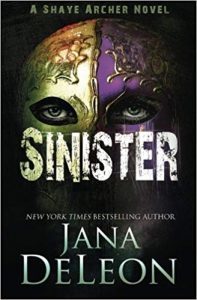Cora Buhlert's Blog, page 61
February 27, 2020
Retro Review: “Highwayman of the Void” by Dirk Wylie a.k.a. Frederik Pohl
[image error]“Highwayman of the Void” by Dirk Wylie is a space opera novelette, which appeared in the fall 1944 issue of Planet Stories and is therefore eligible for the 1945 Retro Hugos. The story may be found here. This review will also be crossposted to Retro Science Fiction Reviews.
Regarding the author, Dirk Wylie was the name adopted by Joseph Harold “Harry” Dockweiler, a member of the Futurians and frequent collaborator with Frederik Pohl in the 1940s. However, Frederik Pohl subsequently stated that he wrote “Highwayman of the Void” alone and submitted under Wylie’s name. So I will refer only to Pohl as the author from this point.
Warning: There will be spoilers in the following!
“Highwayman of the Void” has an absolute killer of a first paragraph:
Steve Nolan was three years dead, pyro-burned in the black space off Luna when a prison break failed. But Nolan had a job to do. Nolan came back.
After this promising start, we follow the undead Steve Nolan across the icy surface of Pluto towards a domed city called Port Avalon. Gradually, we learn that Nolan was once a reporter for the Interplanetary Telenews Company. Now, he’ s looking for revenge on his sworn enemy Alan Woller, his former boss and the man who framed him for treason for supposedly collaborating with a terrorist group called the Junta. Woller’s lies got Nolan a life sentence on Luna. Nolan managed to escape and nearly died. And because he was presumed dead, he decided not to correct the error. But as a result he can never return to the inner worlds. And now Woller is on Pluto, heading a shipping company. Nolan will make sure that he pays for his crimes.
Nolan still has fifteen miles to trudge across Pluto, when he gets lucky and a skid breaks down right in front of him. Nolan forces his way into the skid and persuades the pilot, a young woman, to give him a lift to Port Avalon. In return, he’ll fix the broken skid. The young woman agrees, not that Nolan gives her much of a choice. After an encounter with some local fauna – a giant crab-like critter – Nolan and the young woman reach the city. The young woman – neither we nor Nolan learn her name at this point, with good reason – is quite taken with Nolan and offers to buy him dinner, which is remarkably progressive by 1940s standards. However, Nolan rebuffs her. He has other things on his mind.
He heads to a disreputable bar (are there any other bars in space opera?) named The Golden Ray, where he meets with an old acquaintance, a gambler named Petersen who rescued Nolan after his nigh-fatal prison break and is the only one who knows Nolan’s true identity. Petersen warns Nolan not to go after Woller, because Woller is even more influential than he used to be. But Nolan is determined. He will see Woller dead.
So Nolan sneaks into Woller’s hotel, into what he believes is Woller’s bedroom, only to get the surprise of his life, when he finds not Woller, but the young woman who’d given him a lift, in the bed. “Where is Woller?” Nolan demands, but the young woman refuses to answer. The encounter ends with Nolan retreating, because he can’t bring himself to shoot an innocent woman, even if she is Woller’s mistress, whereupon the woman raises the alarm and the guards come running.
Nolan braces himself for a shoot-out. But suddenly, alarms go off all over Port Avalon. The dome that protects the city against the harsh environment of Pluto has cracked and is rapidly losing air. Soon, everybody in Port Avalon will be dead.
Nolan knows that he should use the chaos to escape, but instead he goes back into the hotel room and tells the young woman to put on a spacesuit (though Pohl calls them heatsuits). Then he flees, desperate to find a spacesuit for himself. But just outside the hotel, he is intercepted by Petersen, who triggered the dome breach alarm to give Nolan to chance to escape the guards. Petersen also informs Nolan that Woller was called away to Mars in a hurry and that his ship will be leaving in the morning.
Nolan tries to bribe his way aboard Woller’s ship. When that doesn’t work, he just forces his way aboard and hijacks the ship. But when Nolan finally comes face to face with Woller, he doesn’t kill his sworn enemy. Instead, he wants Woller to confess and clear Nolan’s name. But before it come to that, the captain – who is a black man, by the way – and the crew overpower Nolan and lock him up.
When the ship lands, Nolan causes an explosion and escapes in the confusion. He also realises that the ship never travelled to Mars at all. Instead, it just landed in another part of Pluto. Nolan is quickly recaptured – there are a lot of escapes and recaptures in this story. Woller, who was wounded in the explosion Nolan caused, very much wants to kill him. However, first he has other business to attend to and so, in the manner of careless villains everywhere, exposes his grand plan.
Turns out that Woller is the one who is collaborating with the Junta to build a fleet of warships in a secluded part of Pluto. When intrepid reporter Nolan accidentally stumbled upon Woller’s schemes, Woller framed him to get rid of him. Nolan also learns that Woller is not actually the head of the Junta. A man in a mirrored helmet everybody only calls Chief is.
The Chief is not at all pleased to see Nolan and orders one of the others to give him a gun. But once he has it, the Chief aims his gun at his co-conspirators and tells Nolan to disarm them. For the man behind the Chief’s mirrored helmet is not the man the Junta were expecting. But that’s a risk that all villains who hide their identity behind a mask run and in fact I am surprised that it doesn’t happen more often. The fake Chief tells Nolan to put on a spacesuit and blows a hole into the side of Woller’s hideout. The explosion and the loss of air kill many of the conspirators. Nolan and the false Chief flee through the hole and commandeer a skid.
Once aboard the skid, the fake Chief finally takes off his mirrored helmet and reveals none other than Nolan’s good friend Petersen underneath. Petersen finally comes clean and admits that he is no gambler at all, but an agent of the interplanetary police force known as Tri-planet Law. Tri-planet Law knew about Woller’s treachery all along and they also knew that Nolan was being framed. Nolan was never supposed to go to prison, instead he would have been questioned and given a new identity or taken into protective custody. But Nolan messed up that plan with his escape attempt. So Nolan was officially declared dead. Petersen was sent to rescue and befriend him to find out what Nolan knew.
When Nolan couldn’t be deterred from going after Woller, Petersen did his best to protect him, including disguising himself as the Chief to infiltrate the meeting of the Junta leaders.
Nolan insists that since the Junta leaders are all at Woller’s hideout, they must do something about it. Petersen says that’s already being taken care of. Together, he and Nolan watch as Tri-planet Law bombs Woller’s hideout, killing everybody inside and putting an end to the Junta
But there is one more revelation to come. For Petersen also tells Nolan that the young woman he met in Woller’s hotel room is not Woller’s mistress but his stepdaughter Ailse. Ailse found out what her stepfather was up to and was planning to confront him. Before Petersen could intervene, she vanished. Petersen fears she may have been at Woller’s hideout, when it was bombed.
Nolan is devastated, until he remembers a coffin-like box he saw aboard Woller’s ship, a so-called sleep box wherein human beings can be kept in suspended animation. And that same sleep box is now in the cargo hold of the skid Petersen and Nolan commandeered. So Nolan rushes to the hold to kiss Snow White – pardon, Ailse – awake.
[image error]“Highwayman of the Void” is a cracking good, action-packed space adventure, even if the title is misleading, because there is no highwayman anywhere in the story, unless Nolan sort of hijacking Ailse’s skid makes him a highwayman.
Action-packed space adventure is not really something I associate with Frederik Pohl. Nonetheless, his two pseudonymous stories I reviewed for the Retro Reviews project are just that. And in fact, Pohl’s pseudonymous contributions to Planet Stories feel very much as if Frederik Pohl was trying to channel Leigh Brackett.
The opening scenes of “Highwayman of the Void” with Nolan trecking across the icy wastes of Pluto and later walking the mean streets of Port Avalon sound very much like Brackett in her noir mode. And in fact, I wouldn’t have been surprised if “Highwayman of the Void” had turned out to be a forgotten golden age Leigh Brackett story. Though I suspect that Leigh Brackett would have given Ailse a more active role than spending the bulk of the story as Snow White in a sleep box.
The most notable difference between Leigh Brackett’s and Frederik Pohl’s takes on noir space opera is that in Pohl’s stories, representatives of the authorities are portrayed mostly positively. Petersen, the Tri-planet lawman posing as a gambler, is a good example. Meanwhile, Leigh Brackett has much less faith in the system. In her stories, interplanetary police officers mainly exist as a foil for the outlaw heroes, Lundy from “Terror Out of Space” and Simon Ashton from “Queen of the Martian Catacombs” and the Skaith trilogy being notable exceptions.
And even though Steve Nolan is a convict on the run with revenge on his mind, he is not a typical outlaw protagonist like the ones Leigh Brackett favoured. Instead, Nolan is the heroic journalist, a common character type in popular fiction during the 1930s and 1940s, who took on the wrong corrupt capitalist and was framed for a crime he did not commit. There are several crime movies of the 1930s with this very plot. One example that comes to mind is the 1939 prison drama Each Dawn I Die starring James Cagney. There were others as well. Indeed, it is often forgotten that golden age science fiction drew on influences from beyond the SFF genre spectrum, influences which are more difficult to detect today, because the tropes in question have often vanished.
“Highwayman of the Void” suffers a bit from what I call Van Vogt plotting, i.e. there is a random plot twist every 800 words or so. Though attributed to A.E. van Vogt, the frequent plot twists were a common technique in the pulp era. Lester Dent’s famous pulp fiction master plot, requires a plot twist every 1500 words, though Dent was better at pulp plotting than van Vogt (but then pretty much everybody was) and his plot twists usually make sense.
“Highwayman of the Void” has plenty of plot twists and several of them seem rather random at first glance. Our hero is trapped by the goons of the villain with no way out. Oh look, a handy dome breach alarm, quell coincidence. No wait, there is no dome breach – the hero’s pal has triggered the alarm to give our hero a chance to escape. And then our hero has been captured by the villains – again – and is only seconds from execution, when he is rescued by an unknown saviour wearing the mirrored helmet of the conspirators’ leader. What a coincidence – again. And then the unknown saviour is revealed to be the hero’s best pal – again. Hmm, that guy sure gets around and also knows a whole lot for a guy who gambles for a living in dingy spaceport bars. Oh, he’s really an undercover policeman – that explains a lot.
Pohl is already a skilled enough writer at this point of his career to come up with logical explanations for his seemingly random plot twists, though he isn’t yet skilled enough to avoid the pulp school of plotting with its random plot twists altogether. There also are some loose ends, for example the true identity of the Chief in the mirrored helmet is never revealed. That said, it is notable that Frederik Pohl was a better writer at this point of his career than his friend and near contemporary Isaac Asimov, though not yet as good as his other contemporary Ray Bradbury. Pohl is mostly remembered for his fandom activities during the 1940s, but he was already a good writer and editor at this time. Even if “Highwayman of the Void” and his other stories from this period have been reprinted only once in a collection fittingly entitled The Early Pohl.
Another problem with “Highwayman of the Void” is that there is too much plot for a novelette length story. Usually, golden age science fiction stories are exactly the right length for what the idea and plot will support. Occasionally, they are too long, padded out with technobabble and random plot twists. “Highwayman of the Void” is the rare example of a story from this era that I wish would have been longer. Because a novella or even novel-length story would have given Pohl the chance to flesh out the plot and the characters more.
After reading a lot of golden age science fiction stories in a row, including several from the more lurid end of the market such as Planet Stories, Startling Stories and Thrilling Wonder Stories, I’ve noticed that many of those stories are set in the same consensus version of the solar system. In this pulp science fiction shared universe, Earth is the dominant force and the tri-planet configuration of Earth, Mars and Venus is the centre of civilisation. Sometimes, Mars and Venus have native humanoid populations, sometimes their populations are the human descendants of early colonists (see “Double-Cross”, also by Frederik Pohl). But whichever is the case, Martians and Venusians are usually considered primitive and not on the same level as Earth people. Mercury is inhabited, but a hell world. The rest of the solar system all the way to Pluto (which was still a planet) is inhabited as well, though anything beyond Mars is the wild frontier. Space cops patrol the space lanes.
Earth’s Moon serves a prison in this universe (and would still be portrayed as a prison world all the way to Robert A. Heinlein’s The Moon Is a Harsh Mistress in 1966 and beyond – e.g. the Second Species Trilogy by Jane O’Neill features a prison on the Moon in a 21st century series) from which the protagonists either escape or try to prevent being sent there. I’ve never actually read a golden age story set in the prison on the moon (The Moon Is a Harsh Mistress doesn’t count, since it’s a 1960s story), but the place sounds about as cheery as a Soviet gulag of the same period.
Science made this pulp science fiction shared universe obsolete in the 1960s, when space probes reached Mars, Venus, the Moon and later on the other planets of the solar system. But nonetheless, we can still see the influence of this pulp science fiction shared universe in contemporary science fiction. The Expanse is set in an updated version of the pulp science fiction shared universe. Earth and Mars are the human core worlds (and perpetually at loggerheads), though science has taken Venus and Mercury out of the game. Meanwhile, the belt and the moons of Jupiter are the wild frontier, populated by marginalised and exploited people and beset by space pirates, murderous capitalists, local revolutionaries and terrorists, space Mormons and fedora-wearing detectives who walk the mean streets of Ceres.
A far more common approach is just transposing the pulp science fiction shared universe to another solar system with more habitable worlds than our own or just the entire galaxy. How many space opera universes feature core of wealthy, high technology worlds (which we rarely visit, because the protagonists usually can’t show their faces there) and a galactic rim of much more primitive frontier worlds, which are often oppressed by the core worlds? It’s an extremely common set-up in space opera, used by Star Wars and Firefly among others. Even my In Love and War universe features a similar set-up. This trope is so common that we have almost forgotten where it came from.
“Highwayman of the Void” is a good example of a story set in the pulp science fiction shared universe of the golden age. A fine noir space adventure that deserves more recognition than it got.
 Send to Kindle
Send to Kindle
Indie Crime Fiction of the Month for February 2020
 Welcome to the latest edition of “Indie Crime Fiction of the Month”.
Welcome to the latest edition of “Indie Crime Fiction of the Month”.
So what is “Indie Crime Fiction of the Month”? It’s a round-up of speculative fiction by indie authors newly published this month, though some January books I missed the last time around snuck in as well. The books are arranged in alphabetical order by author. So far, most links only go to Amazon.com, though I may add other retailers for future editions.
Our new releases cover the broad spectrum of crime fiction. We have cozy mysteries, small town mysteries, hardboiled mysteries, historical mysteries, Victorian mysteries, Jazz Age mystries, holiday mysteries, paranormal mysteries, crime thrillers, psychological thrillers, paranormal thrillers, police procedurals, romantic suspense, amateur sleuths, police officers, ex-spies, serial killers, domestic abuse, suspicious suicides, crime-busting witches, crime-busting tour guides, murderous Valentines, crime and murder in London, Paris, New Orleans, Miami, Los Angeles, Indiana, Wisconsin, Warsaw and much more.
Don’t forget that Indie Crime Fiction of the Month is also crossposted to the Indie Crime Scene, a group blog which features new release spotlights, guest posts, interviews and link round-ups regarding all things crime fiction several times per week.
As always, I know the authors at least vaguely, but I haven’t read all of the books, so Caveat emptor.
And now on to the books without further ado:
 Death by Baguette: A Valentine’s Day Murder in Paris by Jennifer S. Alderson:
Death by Baguette: A Valentine’s Day Murder in Paris by Jennifer S. Alderson:
Paris—the city of love, lights … and murder? Join tour guide Lana Hansen as she escorts five couples on an unforgettable Valentine-themed vacation to France! Unfortunately it will be the last trip for one passenger…
Lana Hansen’s future is looking bright. She has money in her bank account, a babysitter for her cat, and even a boyfriend. Regrettably she won’t get to celebrate Valentine’s Day with her new beau, Chad. Instead, she will be leading a lovers-only tour in France. Luckily for Lana, her best friend, Willow, and her partner, Jane, will be joining her.
Things go downhill when Lana’s new boyfriend shows up in Paris for her tour—with his wife. Chad is not the website developer he claimed to be, but a famous restaurant critic whose love of women rivals his passion for food.
After Chad drops dead during a picnic under the Eiffel Tower, a persistent French detective becomes convinced that he was poisoned. And the inspector’s sights are set on several members of the tour—including Lana!
While escorting her group through the cobblestone streets of Montmartre, the grand gardens of Versailles, and the historic Marché des Enfants Rouges market, Lana must figure out who really killed Chad before she has to say bonjour to prison and adieu to her freedom.
Introducing Lana Hansen, tour guide, reluctant amateur sleuth, and star of the Travel Can Be Murder Cozy Mystery Series. Join Lana as she leads tourists and readers to fascinating cities around the globe on intriguing adventures that, unfortunately for Lana, often turn deadly.
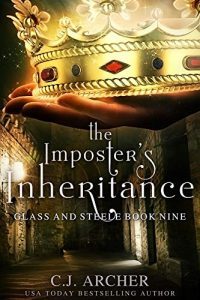 The Imposter’s Inheritance by C.J. Archer:
The Imposter’s Inheritance by C.J. Archer:
A sordid scandal rocks the Glass household and threatens to ruin Matt’s family unless he can suppress it. But after word gets out, and a rare magical coronet is stolen, he and India find themselves scrambling to recover the heirloom and suppress the gossip before reputations are ruined.
To make matters worse, someone is sending threatening letters to the magicians of London, stirring up trouble between the artless and magicians. Tensions are rising, but India and Matt choose not to investigate – until the author of the letters is assaulted.
As if they don’t have enough on their plate, Willie is jailed. The reason for her arrest is…complicated.
 What Lies Beneath by David Archer:
What Lies Beneath by David Archer:
Fresh out of high school and off to college, Cassie thought she had the world by its tail, and then she met Mike. Tall, handsome and a police detective to boot, he swept her off her feet and into a whirlwind relationship that led to an engagement ring.
But things aren’t always as they seem, and Cassie comes to discover that Mike has a dark side. When she learns just how dark it can be, she comes face-to-face with the greatest forward she could imagine, and it leaves her burned and scarred for the rest of her life.
Cassie isn’t one to wallow in misery. She takes her experiences and a degree in psychology and sets out to help other women avoid the kind of thing that happened to her, but then one of her clients comes to her in desperation. Her abusive husband has kidnapped her daughter, and it’s up to Cassie to find the girl before it’s too late.
Of course, then the only trick is how to survive.
 Bérénice Jacquette, Part 1 by S. Ann Austin:
Bérénice Jacquette, Part 1 by S. Ann Austin:
The Past:
She was taken from a rundown farmhouse and brought to an isolated cabin. The sounds of a little girl crying echoes across the bayou. No one can hear her. No one will rescue her.
The Present:
Twenty-seven-year-old Bérénice Jacquette survived a horrific childhood in the swamplands of Louisiana only to wind up trapped in a bitter, loveless marriage. In spite of a traumatic past still haunting her, she is determined to find her independence. Harboring ambitions to be a successful author, she attempts to pen a work of fiction.
The chef of a popular restaurant in New Orleans, she believes no one suspects her of committing murder through the use of black magic while writing a realistic crime novel.
When a handsome and charismatic homicide detective named Gary Northcutt steps into her life she doesn’t wonder if he knows her secrets. She thinks only about how he can be useful to her.
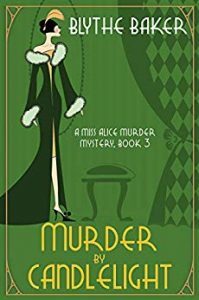 Murder by Candlelight by Blythe Baker:
Murder by Candlelight by Blythe Baker:
A dramatic death…
When an evening’s entertainment unexpectedly turns into a night of death, Alice Beckingham must discover the motive behind a very public murder. But with hundreds of witnesses, narrowing down her suspects isn’t easy. Worse, her investigation makes Alice a target for a killer who doesn’t want to be caught.
With the always aloof Sherborne Sharp assisting, can Alice stay alive long enough to solve the puzzle? Or will the next curtain rise on yet another murder – her own?
 Illusions of Warsaw by David Bradwell:
Illusions of Warsaw by David Bradwell:
A suspicious suicide. A vengeful girl. Connecting the dots could send a group of friends to the morgue..…
Warsaw, 1997. Fugitive journalist Clare Woodbrook refuses to ignore a colleague’s questionable death. Teaming up with a fellow reporter, she uncovers a trail of corruption that could expose the killer. But when they get too close to the truth, they’re framed for a series of bloody crimes.
London. Secretive, bright-eyed Louise arrives on Anna Burgin’s doorstep, claiming to be Clare’s long-lost niece. But her true agenda is simple and deadly: revenge for her father’s murder. And her ill-conceived plan to infiltrate a crew of con artists puts both Anna and her in a vicious gangster’s crosshairs.
As Clare discovers shadowy links between Poland and Britain, she races against time to clear her name and reveal the culprit before more body bags fill. But with Louise and Anna caught up in the mess in England, it might be too late to save everyone…
Can the unlikely team catch a sinister mastermind before they’re ruthlessly erased?
Illusions of Warsaw is the sixth book in the twisty Anna Burgin mystery-thriller series. If you like fearless characters, Nineties nostalgia, and pulse-pounding suspense, then you’ll love David Bradwell’s breathless tale.
 Mystery on Valentine’s Day by Beth Byers and Lee Strauss:
Mystery on Valentine’s Day by Beth Byers and Lee Strauss:
The worlds of Ginger Gold and Violet Carlyle collide in this fun Valentine Mystery short story by bestselling authors Lee Strauss and Beth Byers.
While both Ginger and Violet had plans for a romantic evening of dinner and dancing to celebrate Valentine’s Day with their husbands, something goes terribly awry. One by one, female patrons discover that they are missing jewelry.
In this closed room mystery filled with a brigade of colorful characters, Violet and Ginger join forces to put their skills of deduction to work. Can they unveil the culprit and solve the mystery in time for dessert?
Don’t miss this delectable bite-sized tale. Pairs perfectly with a box of chocolate and a comfy chair!
 No Trivial Pursuit by John Ellsworth:
No Trivial Pursuit by John Ellsworth:
No Trivial Pursuit. Not When It’s Your Own Daughter Missing.
A front-page murder is assigned to LAPD Detective Harley Ellis and her partner. Hollywood studio head Ira Spielman has been murdered. His widow says he had no enemies. Except one, says Harley, and she must discover who that is and why. She knows he sometimes interviewed actresses alone in his Hollywood office. Harley wonders: did he make a wrong move? It’s not much, but it’s a starting point. She would know: her own daughter had a screen test with Spielman before he was killed.
Robbery-Homicide Division begins an investigation that obtains the name of Harley’s daughter. Is she a suspect? No, but she’s a person of interest. Charges get filed. The LAPD investigation is put beneath the microscope. Will Harley’s investigation of a totally different suspect be vindicated? The amazing conclusion to this thoughtful investigation culminates in a final chapter few will see coming.
Life gets complicated!
Former cop, Dickie Mullins, owns the Emporium of Dance. A sleazy pick-up bar with lousy food and about to go broke.
Rae Nell, Dickie’s ex-wife, is having an affair with NFL washout, Terry Taggert.
Terry is starting a steak business. Delicious, unique steaks.
Rae Nell thinks it would be a good idea if Dickie improved his menu.
Meanwhile, Terry’s principal investor, ‘Dr.’ Craig Cullen wants out, NOW!
Terry has just the plan for the ‘Dr.’ Cullen.
 The Heartless Valentine by Kacey Gene:
The Heartless Valentine by Kacey Gene:
Roses are red; violets are blue
Is a lover from the dead here to kill you?
Valentine’s Day. 2020. Middlebridge, Wisconsin. When the quick-witted second grade teacher and amateur sleuth, Jennifer Hunter, receives a gift from a secret admirer on Valentine’s Day, she heartily investigates who her cupid could be. When she opens the box, though, she doesn’t find chocolates; she finds a human heart wrapped in red tissue paper.
And that’s not all. Her admirer has written a note confessing their desire to watch Jennifer die. That’s when Jennifer’s best friend and Middlebridge’s Police Lieutenant, Jake Hollow, steps in.
Jake and Jennifer put their dynamic duo focus on finding Jennifer’s deranged valentine, and that leads them to the recently deceased body of David Bird IV. He looks like an average dead guy except for one fact — his heart has been removed. Jennifer must investigate this heartless valencrime; otherwise, she fears she’ll be the next victim. Yet, her attempt to protect her own heart leads her to a set of love letters that tell the story of broken hearts from the past.
Valentine’s Day. 1910. Salem, Massachusetts. Clay Trunkett, a twenty year old hard-working journalist, is scheduled to hang for assaulting a man. His accuser? David Bird II, son of the wealthiest man in Salem. Clay’s true crime? Falling in love with Meghan White, the woman David has his heart set on marrying.
The love triangle of 1910 holds the clues Jennifer needs to find the heart snatcher of 2020, but with her own crazed valentine delivering threatening messages and bits of heart like they’re candy, Jennifer struggles to piece together this crime of passion from 1910.
And, Jennifer’s own passions get in the way when she discovers that her best friend, Jake, has a girlfriend — one that he’s been hiding from Jennifer for months. Betrayal runs high as masquerade parties, craft sales, murder mystery dinners, and a strange encounter at the local diner all distract Jennifer from her one mission: To find out who’s making her Valentine’s Day the most horrifyingly heart-filled in history. The problem is, Jennifer’s discoveries may end her friendship with Jake, and that’s a heartbreak she can’t take.
This clean cozy mystery will keep reader’s hearts pounding as they flip through love letters from the past and the alternating stories of Jennifer Hunter and Clay Trunkett. Jennifer’s down-to-earth and lovable personality plunges into new territory as she must assess her relationship with Jake and the type of love she wants in her life. She goes on crochet benders; she attends parties where she gets to be someone other than herself; and all the time she’s piecing together a crime that makes this Valentine’s Day anything but sweet.
 Nest of Vipers by Natalie Hames:
Nest of Vipers by Natalie Hames:
Seeing is deceiving.
A layer of freezing fog hovered on the ground, nipping at Andrea Rossi’s ankles as she ran along the secluded trail in Kensington Gardens. It was no ordinary day. In a few hours time, she would be facing a prolific child killer in a legal battle that would change her career, forever. But Andrea would never see the inside of a courtroom, again. Nor would she reach the end of her favourite trail. A few more paces, and Andrea Rossi would be dead.
DI Dalton and DS Nash embark on an investigation to find the killer. They do not have to look very far before they come across Mark Templeton, a man with a history of violence and the father of a murdered child. He has motive and an insurmountable rage making him highly capable of carrying out the brutal slaying. Grace and Ryan proceed with caution and question him to find he has no sympathy for the young Barrister’s death. But as they gather more information, they unearth more suspects and more motives. Initially obvious theories become increasingly blurred as details of Andrea’s private life gradually unfold. Did Mark Templeton really kill her for defending his son’s killer, or are there far deeper and darker motives at play?
 Boot Scootin’ Boogeyman by Lily Harper Hart:
Boot Scootin’ Boogeyman by Lily Harper Hart:
Hannah Hickok didn’t know she was a witch but now that she’s embracing her destiny, she can’t wait to learn about magic. Given the trouble that seems to find Casper Creek on a regular basis, that’s probably a good thing.
Cooper Wyatt is enjoying watching Hannah open up and learn about herself. He’s there to lend a helping hand but also eager for her to strike out on her own … until the unthinkable happens. On their first official date, Cooper and Hannah bear witness to a horrifying scene. A local woman, who had gone missing days before, jumps off a downtown building and kills herself. The question is: Why?
There’s more than one missing woman, magic sparking at every turn, and a monster on the hunt. It’s up to Hannah, Cooper, and the rest of their friends to discover exactly what’s going on … and figure out how to solve the problem. That’s easier said than done, though.
Casper Creek’s magic runs deep and Hannah is going to have to tap into it if she expects to keep her friends safe.
She’s up to the challenge.
At least she hopes she is.
Things are about to get messy as the Wild West gets wickeder and wickeder.
 Valentines & Victims by Donna Muse:
Valentines & Victims by Donna Muse:
After being snowbound for much of the winter, amateur detective duo Geneva Pomolo and Iris Reeves are looking forward to a Valentine’s Day getaway with a few older friends at Bittersweet Lodge, a ski resort in the chilly foothills of southern Indiana. Both women are looking forward to a weekend of dance contests, luaus, roasted pigs, and toboggan scavenger hunts. Tensions mount when one of their friends comes down with a sudden illness. Geneva fears the worst: someone is poisoning the lodge’s guests.
The case takes a deadly swerve when Horace Weatherspoon—millionaire head of a railroad empire—dies in a toboggan accident. The old man had been deathly afraid of toboggans and Geneva knows there is malice at work: one of their fellow guests is a murderer. As Iris and Geneva begin to investigate, they uncover a trail of secrets leading back more than thirty years, and one person will kill again to keep those secrets buried.
 Be My Valencrime by Amy M. Reade:
Be My Valencrime by Amy M. Reade:
It’s Valentine’s Day in Juniper Junction and love is in the air. Or is that just a dark cloud?
Lilly’s shop assistant, Harry, is about to pop the question to his girlfriend, Alice Davenport. He’s got the ring, he’s planned a romantic dinner, and he’s even thought of a gracious escape if Alice says no.
The only thing missing is…Alice.
Lilly wants to do all she can to help find Alice, even if that means interfering with a police investigation. But as she begins to learn more about Harry’s sweet, unassuming girlfriend, she discovers that Alice is hiding a shocking secret that will complicate everything.
And when Lilly suffers a lapse in judgment, the consequences are swift and painful. Can she pull herself together enough to help her daughter through a tunnel of teenage angst, deal with her mother’s dementia-related wanderings, and still help Harry find his Happily Ever After?
 The Girl in the Manor by A.J. Rivers:
The Girl in the Manor by A.J. Rivers:
The sound of a blood curdling scream echoed through the manor.
Her pleas ignored, her screams unheard. Tomorrow would not come for Everly Zara…
What does the death of a young child, and the sudden death of the girl in the manor have in common?
Was it simply just a coincidence, or is there something far more disturbing than anyone could ever imagine?
Everly Zara, a beautiful young woman, is found dead in the bedroom of the manor. The bedroom which she shares with her new fiancé.
She is naked and hanging. Her ankles are bound. There are words written on her body.
The news is shocking and disturbing to everyone who knows her.
Could Everly no longer bear the sadness and guilt of the little boy’s death, and killed herself to escape it?
But the heartbreaking death of a beautiful young woman accused of a horrible act may not be as straightforward as everyone thought.
The further Emma dives into the case, the more she realizes, everything is not as it seems.
As secrets from Everly’s past rise to the surface and the shocking nature of it discovered.
Emma must unravel the truth before she becomes a victim herself. In the close-knit town of Sherwood, something or someone is coming for Emma Griffin.
With her past constantly haunting her, and the disturbing nature of this mystery. Nothing is what it seems, yet everything feels so familiar. Emma is left to wonder if she is really losing her mind.
How deep down the rabbit hole will Emma go to find out the truth of her past?
How far will she go to find out the truth behind Everly Zara’s death?
One thing’s for certain, Emma’s entire world will be forever changed once the truth is revealed.
When a mother and her child are pulled out of the harbor in their car, the case seems pretty straightforward for Miami PD and Detective Harry Hunter.
Everything points to a murder-suicide.
They were homeless, living in their car, and the mother decided to end it all for them both by driving into the water.
But the case is not what it looks like, Detective Harry Hunter soon realizes.
Harry’s daughter is carrying devastating knowledge about their deaths, and soon she becomes the killer’s next target.
As Harry races to protect her, he is betrayed by someone he thought he knew, leaving him terrified of trusting anyone in a town filled with liars.
Redemption. Love. Betrayal. An ancient evils stirs. Unleashing… The Paladin.
James Goltree put Mariposa in his rearview mirror five years ago, escaping a past and a family he’s desperately ashamed of. But now the Air Force Office of Special Investigations agent must return after the death of his grandfather. The grandfather he helped send to prison.
Emergency room LPN Madison Campbell’s quiet life is turned upside down when her son inherits enough money from James’ grandfather to settle all their financial woes. But there are strings.
James and Madison throw sparks neither has ever felt before. But now isn’t the right time for a man unwilling to commit and woman still crippled by betrayal to fall in love.
Not when a killer has once again come to town, one with an unfathomable, unbelievable agenda.
James and Madison must embrace and overcome their pasts to defeat evil and find a love that transcends time.
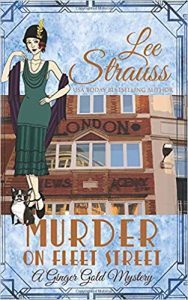 Murder on Fleet Street by Lee Strauss:
Murder on Fleet Street by Lee Strauss:
Murder’s a Deadly Secret!
Mrs. Ginger Reed—the former Lady Gold—thought her past was dead and buried, but when the mysterious death of a British secret service agent threatens to expose her own Great War secrets, she’s faced with an unimaginable dilemma: break her legal vow to the Official Secrets Act or join the agency again, something she’s loathe to do.
Because once they own your soul, there’s no getting it back.
 Send to Kindle
Send to Kindle
February 26, 2020
Star Trek Picard does the “Stardust City Rag”
Welcome to my latest episode by episode review of Star Trek Picard. Previous installments may be found here.
This review is a bit later than usual, because I was tired and not feeling well and therefore didn’t get to watch “Stardust City Rag”, the latest episode of Star Trek Picard, until Saturday. Though the episode was worth the wait.
Warning: Spoilers behind the cut!
“Stardust City Rag” follows the by now common pattern of Star Trek Picard and opens with a flashback to events 13 years prior. Though this flashback is much gorier than what I at least would expect from Star Trek, since it shows a young man in a Starfleet uniform getting his eyeball gouged out in close-up. The eyeball is attached to some kind of black cable – the young man is an ex-Borg.
The vivisectionists aren’t finished yet. They’re looking for further Borg components, because Borg tech is apparently valuable (also see the Romulans dismantling the dead Borg cube). But before they can finish, Seven of Nine storms in and shoots the vivisectionists. She rushes over to the young ex-Borg and cradles him in her arms. But it’s too late. He’s dying and in pain. So Seven finishes the job. “Good-bye, my child”, she says. Now we realise that the young ex-Borg is a character we’ve seen before, namely Icheb, one of the Borg children whom Voyager rescued towards the end of its run and whom Seven took under her wing.
Now it’s been ages since I watched Voyager and so I only had a vague memory along the lines of “Didn’t they rescue some Borg kids?” A bit of googling revealed that Icheb was the oldest of those Borg kids and the only one who stayed aboard Voyager, when it turned out that his parents had genetically engineered him as Borg bait. Icheb wanted to join Starfleet, which isn’t surprising considering that his entire life consisted of murderous parents on an agrarian world, being a Borg drone and then life aboard Voyager, which was the only time his life was ever remotely good. No wonder he wanted to join Starfleet and eventually did. Icheb is no longer played by the same actor who portrayed him in Star Trek Voyager BTW, because that actor has turned out to be something of a jerk.
As for why Icheb’s death hits Seven so hard – in fact, I think it’s the first time we’ve ever seen Seven cry – she was the primary caregiver for Icheb and the other Borg kids aboard Voyager. Also, it’s implied that Seven cannot have biological children due to her Borg implants, so Icheb was the closest thing to a child she’ll ever have. But the main purpose of the gorey opening scene (a lot gorier than anything in Star Trek and more along the lines of the grimdark new Battlestar Galactica and its ilk) is to show that Seven has changed a lot in the approx. twenty years since we last saw her.
This change is also visible in Seven’s appearance. Gone are the silver catsuit and the severe bun. Instead, she wears her hair open and is clad in jeans, a sweater (and what is it with the deliberately hadmade looking sweaters in Star Trek Picard anyway? Did the replicator finally figure out how to reproduce knitting?) and a really cool leather jacket. It’s also notable that unlike Icheb, Seven did not stay with Starfleet. And considering how xenophobic and isolationist the Federation and Starfleet have become, I wonder how voluntary that decision was. Chakotay, by the way, is nowhere in sight, which suggests that Seven’s relationship with Chakotay did not last. Which is not very surprising, considering how tagged on it always felt.
Instead of Starfleet, Seven is now with an outfit called the Fenris Rangers, a sort of freelance vigilante army who try to keep the peace in the former Neutral Zone, since Starfleet can’t be bothered. Picard disapproves, because even though he disagrees with Starfleet disengaging from everything (What precisely are Starfleet doing these days anyway? Analysing cosmic phenomena which will eat starships? Is there even still an actual Starfleet or is it just a bunch of admirals sitting around in San Francisco?), he also believes that taking the law into your own hands is wrong. Never mind that taking the law into his own hands and doing what Starfleet won’t do is exactly what Picard is doing. But then – much as I like him – Picard has always operated as if there is one set of rules for Jean-Luc Picard and one set of rules for everybody else.
“Stardust City Rag” is the first time Jean-Luc Picard and Seven of Nine meet face to face, at least on screen. They may have met in a tie-in novel or a comic or something along those lines, but if so I don’t knwo about it. Though of course, Picard and Seven know each other by reputation. And they briefly were part of the same Borg collective, back when Picard was Locutus. And indeed, Picard and Seven discuss their experiences as former Borg, when Seven asks Picard if he believes he got his humanity completely back when he was deborgified. Picard says no, but that he keeps hoping to regain more and more of it. Seven clearly feels the same, though it is notable how much more human this version of Seven of Nine seems compared to how she was portrayed in Voyager. And talking of Seven, it’s quite delightful how Rios (Rios Prime, not one of his holograms) fangirls her, just as he fangirled Picard earlier. At time, Rios almost strikes me as a stand-in for all the Star Trek fans in the audience, who can’t quite hide his awe at getting to meet so many legends of Starfleet (and based on the trailers, he’ll get to meet a few more).
After they rescued Seven from her exploding ship, the crew of the La Sirena proceed to a place called Freecloud, where Raffi has located Bruce Maddox. Freecloud is your typical neon-drenched cyberpunk city, a place which is pretty much a science fiction cliché by now, albeit a cool one, but that we’ve hardly ever seen on Star Trek for some reason. Indeed, it is notable that Star Trek Picard delves into a lot of stereotypical science fiction tropes (also see Chris Rios himself) that have appeared everywhere except Star Trek. Not everybody is happy with this, as for example this post by James Wallace Harris shows wherein he bemoans that Star Trek Picard does not contain enough science fictional ideas and too much character focus for his taste.
Unfortunately, Maddox is in dire straits. Not only did the Romulans destroy his lab, no, Maddox also trusted the wrong crimelord – a woman named Bjayzl (played by Necar Zadegan) who looks distractingly like a young and evil Deanna Troi – and finds himself drugged and offered for sale to the Romulans. Bruce Maddox, by the way, has also been recast, though not because the original actor is a known jerk, as with Icheb. According to Keith R.A. DeCandido, the original actor Brian Brophy is now director of a university theatre in California and still proud of his lone Star Trek appearance. Maybe there was a scheduling conflict. At any rate, Bruce Maddox is played by a different actor now who – as Camestros Felapton notes – looks uncannily like Jordan Peterson.
Raffi quickly figures all this out, once the La Sirena reaches Freecloud and everybody on board except for Seven and Elnor is inundated with hilarious targeted holo-ads. “Can’t we just outbid the Tal Shiar?” Captain Rios asks, whereupon Raffi replies that you don’t outbid the Tal Shiar. Seven, however, has an idea. For Bjayzl will sell Bruce Maddox to someone other than the Tal Shiar, provided you offer her something she really wants. Such as a former Borg who still has plenty of Borg hardware in her body. And as we know from the gory opening scene (and from Hugh’s comments two episodes before), there is a market for Borg tech ripped out of its former owners. And no, I have no idea what anybody wants Borg tech for either. That’s a question that Star Trek Picard really needs to answer.
And so the con is on. Rios poses as a so-called “facer”, a broker who brings the parties in deals of questionable legality together. Coincidentally, this destroys the theory that Rios might be a hologram himself, unless he has a mobile emitter like Voyager‘s Doctor. But even then, holograms don’t smell and don’t react to drugs. Seven is the captive/product to be sold. Picard is the seller, Elnor is his bodyguard, which causes some problems because, as we learned last week, Elnor was raised by an order of Romulan warrior nuns who always tell the truth, therefore he cannot lie or pretend to be something he’s not. “Then just be yourself. Be Elnor,” an exasperated Picard says. “Elnor who doesn’t talk,” Seven adds.
The con also involves Rios and Picard dressing up in seriously silly clothes. Rios gets a green sequined jacket, a matching fur coat and an orange hat with a feather, while Picard gets to dress like a pirate, complete with eyepatch and an outrageous French accent. Santiago Cabrera and Sir Patrick Stewart are clearly having a lot of fun hamming it up. The flashy clothes in the Stardust City scenes also hearken back to the very colourful look at the future that Star Trek has traditionally offered, from the original series all the way through Voyager. Star Trek Discovery and Picard both look positively murky by comparison.
Of course, the con doesn’t go nearly as smoothly as hoped. Rios does manage to pass a meeting with Bjayzl’s representative, a member of a reptilian species who can smell lies (as well as whom you had sex with and what you last ate) via getting shot up to his gills with drugs. However, the actual meeting with Bjayzl goes completely and utterly wrong, as soon as someone yanks the hood from Seven’s face. For it turns out that Bjayzl and Seven share a history, a history that’s not good. For apparently, Bjayzl worked with Seven in the Fenris Rangers before turning to crime – or maybe she was a criminal all along posing as a Ranger to get inside info. Of yes, and Seven blames Bjayzl for the death of Icheb and wants revenge.
Gavia Baker-Whitelaw believes that the scene implies that Seven and Bjayzl used to be lovers, which would certainly be cool, though I personally don’t see it. Okay, so Bjayzl calls Seven by her human name Annika, which implies a certain degree of familiarity. But then, Bjayzl is begging for her life in that scene, so appealing to Seven’s human side would be a good plan.
The meeting with Bjayzl and her henchpeople ends in a Mexican standoff type situation with everybody aiming phasers at everybody else. “Are we no longer pretending?” Elnor asks, after everybody has long blown their cover. “No, we’re not”, an exasperated Picard replies, whereupon Elnor proceeds to disarm Bjayzl’s henchpeople. By the way, have I mentioned that I love Elnor? True, he didn’t get much to do in what is only his second episode, but I love the juxtaposition between his childlike naivite and his lethal fighting skills.
Seven fully intends to shoot Bjayzl, but Picard talks her out of it – or so he thinks. Because even though Seven beams back to the La Sirena with the rest of the crew as well as Maddox, she later borrows two phasers from the La Sirena‘s stock – because the Rangers always need phasers, she tells Picard – and beams back down again to Freecloud and shoots Bjayzl as well as her henchpeople anyway. “But you… you promised…” Bjayzl stammers just before she is blasted to smithereens. “Picard is an old man”, Seven replies, “He needs some hope. I’m beyond that.”
And just in case Seven of Nine shooting an admittedly unpleasant villainess (though an attractive one) in cold blod wasn’t shocking enough for you, “Stardust City Rag” serves up yet another shocking death. For Bruce Maddox is badly wounded, when Picard and friends rescue him. He is taken to the sickbay of the La Sirena at once, where he tells Picard that he sent Soji (whom we don’t see in this episode. Ditto for Narek and Narissa) to “the artefact” a.k.a. the dead Borg cube in Romulan space.
Dr. Agnes Jurati – who, as we learned earlier, used to be in a relationship with Maddox, even though he is roughly twice her age – shoos Picard away, because Maddox needs medical attention. Once Agnes is alone with Maddox, he tenderly calls her Aggie and asks her if she met Dahj and if she has seen how wonderful Dahj is. Agnes is crying the whole time, which doesn’t alarm neither Maddox nor anybody else, because Agnes has been a bundle of nerves throughout the episode to the point that she was barely able to operate the transporter. But then, Agnes keeps telling Maddox over and over again how sorry she is, but if he only knew what she knew, as medical alarms go off and the emergency medical hologram is triggered. Agnes switches off the emergency medical hologram, as Maddox finally catches on that something is dreadfully, seriously wrong. But it’s too late, because Agnes kills him.
Of course, it always did seem mightily convenient that Agnes showed up at Chateau Picard just in time to shoot a Zhat Vash agent. And then there was Agnes’ meeting with Commodore Oh, the high-ranking Starfleet officer who is a Romulan Zhat Vash agent pretending to be Vulcan. A meeting which we didn’t see and for which we only have Agnes’ word regarding what occurred. However, Agnes was obviously lying and Commodore Oh seems to have convinced her with her whole “Dahj and Soji are the Destroyer and will bring about the destruction of the whole universe, because an ancient Romulan legend says so” shtick. Which is surprising enough in itself, because Agnes Jurati is a scientist after all and therefore I’d assume that she wouldn’t just accept some shaggy dog story about killer androids destroying the universe without at least questioning the whole thing.
Furthermore, how exactly does Agnes expect to get away with murdering Bruce Maddox? Okay, so Maddox was grieveously wounded, so his death may not be questioned at first. But Rios’ emergency medical hologram must keep logs and sooner or later someone will review those logs. Rios or more likely Raffi. Never mind that Agnes is about as bad at lying as Elnor, so she really doesn’t stand a chance.
Keith R.A. DeCandido believes that Agnes is irredeemable, because she murdered an injured man. I certainly don’t much like her either after this, but I also don’t exactly mourn Bruce Maddox either. For starters, Bruce Maddox is the guy who wanted to disassemble and dissect Data in “Measure of a Man”, which Camestros Felapton just revisited here. Yes, he apparently learned better later on, but how trustworthy was Bruce really? Not to mention that we never really got any sense of who Bruce Maddox was as a person beyond the jerk who wanted to dissect Data. In one of my Star Trek Discovery reviews, I wrote that Captain Christopher Pike used to be the answer to a trivia question, but that season 2 of Star Trek Discovery turned him into a character. Bruce Maddox used to be the answer to a trivia question as well (and one I for one couldn’t have answered without googling), but Star Trek Picard turned him into a plot coupon. All Bruce Maddox gets to do in this episode is drop a hint regarding the next destination and then croak. Maybe that’s why the original actor did not come back, because he didn’t want to be a plot coupon.
As if the episode wasn’t yet packed with enough drama, shock and emotion, Raffi Musiker gets an emotional subplot of her own. After all, Raffi had repeatedly announced that she was only travelling with the La Sirena to Freecloud, where she’d part ways with Picard, Rios and the rest. And once the ship finally reaches Freecloud, we learn just why Raffi wanted to go there. Because on Freecloud, we see a nervous Raffi stepping into what looks like a seriously dodgy fertility clinic. I probably wasn’t the only one who thought, “Uhm, even with 25th century medical technology, aren’t you a little old for that?” But while Raffi is there for a child, she’s not looking to have a baby. Instead, Raffi is looking for her estranged adult son Gabriel, who is less than pleased to see her, because after Starfleet fired her, Raffi apparently drowned her sorrows in drugs and conspiracy theories, neglecting her partner and son. Raffi insists that she has changed, but Gabriel doesn’t believe her and seemingly gets proof, when Raffi snaps at him that “it’s not a conspiracy theory”. As for what Gabriel is doing at a fertility clinic, towards the end of that brief scene we get to meet his pregnant Romulan partner Pel. Did Gabriel enter into a relationship with a Romulan to piss off his mother? It’s possible, though Raffi does not hate ordinary Romulans, e.g. she seems to have no problem with Elnor, just the Tal Shiar and Zhat Vash. And why do Gabriel and Pel need a fertility clinic, when we know that humans and Vulcans can reproduce without any issues, as the existence of Spock attests, and that Romulans are genetically identical to Vulcans?
It’s an emotional scene and gives Michelle Hurd a chance to show off her acting skills, something which the various wife, boss and mother roles in which I’ve previously seen her, didn’t. Though it’s notable that she still gets to play someone’s mother. But apart from giving Raffi something to do, what precisely was the purpose of that scene? To show us that Raffi is a mess? Sorry, but that was pretty obvious already. Though the revelation that Raffi had a husband/partner and a kid does nix my suspicions that she used to have an affair with Picard. Unless she did, which would give Gabriel and Raffi’s unseen husband/partner even more reason to be furious at her.
As always with Star Trek Picard, I thoroughly enjoyed “Stardust City Rag” while I was watching the episode. However, as I struggled to write this review, I realised that this episode is something of a mess that shifts wildly in tone from the goofy caper, complete with silly clothes and accents, to very dark – darker than usual for Star Trek – with the gorey eye-gouging scene, two cold-blooded murders, the deaths of two established Star Trek characters (and while Bruce Maddox may have been the answer to a trivia question, Icheb’s role was more substantial) and a failed family reunion.
Furthermore, I have the sneaking suspicion that “Stardust City Rag” also serves as a backdoor pilot for Star Trek: Fenris Rangers, starring Seven of Nine. Which certainly sounds like a spin-off with a lot of potential and more Seven of Nine is always good. Also, a potential Star Trek: Fenris Rangers would be a much better fit for the “dark Star Trek” series they’re clearly trying to make than either Discovery or Picard. Meanwhile, The Orville is holding up the flag for the more optimistic Star Trek as it used to be, though season 3 seems to be missing in action.
Five episodes in, Star Trek Picard is not nearly as much of an incoherent mess as the first season of Star Trek Discovery was and a lot more fun, too. Though the show does have pacing and tonal issues.
Next episode, it seems as if Picard and the gang will finally find Soji. So it looks as if my prediction that the first season of Picard would be like the first season of The Witcher and that Picard and Soji wouldn’t get to meet until the final episode was off.
 Send to Kindle
Send to Kindle
February 25, 2020
Retro Review: “The Dear Departed” by Alice-Mary Schnirring
[image error]“The Dear Departed” is a ghost short story by Alice-Mary Schnirring, which was first published in the May 1944 issue of Weird Tales and is therefore eligible for the 1945 Retro Hugos. The story may be found online here. This review will also be crossposted to Retro Science Fiction Reviews.
Warning: There will be spoilers in the following.
“The Dear Departed” opens with a séance in progress. Six people are seated around the table, including the medium Radha Ramavi. During the séance, the voice of a child can be heard calling “Mommie, Mommie”. One of the people at the table, a woman named Mrs. Harcourt, recognises the voice as that of her late daughter Dorrie. Clearly upset, she gropes about in the dark and breaks the circle, ending the séance early. When the lights go on again, Mrs. Harcourt is holding a stuffed toy elephant that used to belong to Dorrie, but has been missing since her death.
Radha Ramavi declares that once the circle has been broken, there is no use in going further today. But they can try again tomorrow. Then his assistant, described as a small man in Eastern clothes, sees the guests out, but not before Mrs. Harcourt slips him an envelope containing one hundred dollars, which was a lot of money in the 1940s.
Once the guests are gone, Radha Ramavi and his assistant take off their pseudo-Indian outfits and share a smoke. We learn that Radha Ramavi is really called Joe and that his assistant is called Mark. Neither of them has ever even been to India and Radha a.k.a. Joe cannot really talk to the spirits of the dear departed either. Instead, Joe and Mark are frauds, preying on the despair of the recently bereaved. They acquired the toy elephant from a nurse and used it to fleece Mrs. Harcourt and the others for money.
Joe and Mark head out for dinner and we learn a little more about how their scam works. Mark researches the customers and their dead relatives. He’s also a ventriloquist and produces the voices, while Joe plays the medium. Occasionally, Mark also organises the materialisation of a spirit, using props such as an old Air Force uniform. Since the story was written in the middle of WWII, there would have been a great demand for spirits in uniform and as well as a lot of bereaved parents and widows and therefore a great demand for mediums to talk to the dead. However, Joe and Mark decide to lay off the materialisations for now, because they suspect that one of their customers, a man called Henderson, might be an undercover cop.
By now it’s pretty clear that Joe and Mark are despicable people. But just in case there was any doubt, Mark decides to use his ventriloquist skills to harass a black truck driver waiting at a traffic light, while he and Joe are crossing. And so Mark produces a disembodied voice that whispers “Black boy, debbil’s waitin’ fo’ you,” to the truck driver. As a result, the terrified truck driver slips off the brake, the truck lurches forward and runs over Mark. Poetic justice, I’d say.
Schnirring’s decision to make the truck driver black not just shows that New York City, where “The Dear Departed” is set, was a highly diverse place, it also adds racism to the already long list of Mark’s sins and proves beyond the shadow of a doubt that Mark is or rather was a horrible person. I could have done without a awful accent Schnirring gave the black truck driver, though.
Now that Mark has gotten his comeuppance, Joe is distraught. For starters, he needs Mark or someone with his skills to run his fake medium scam. And besides, Joe was fond of Mark, because Mark worshipped him and would have done everything for him. Like a mongrel who’d do everything for a bone, a pat on the back or a kick. Just in case there was any lingering doubt, Joe comparing his faithful friend and business partner to a dog shows that he is a horrible person, too. Not to mention that we wonder why Mark put up with Joe, especially since Mark was the one who did all the work. Joe just pretended to be a fake medium.
However, Joe still has a séance scheduled for the next day and his customers arrive on cue. Joe has no idea what to do now, cause with Mark gone there is no one to do the voices of the spirits and arrange all the other little tricks. But since he can hardly send his customers home again, Joe decides to go through with the séance and just pretend that the spirits are not in the mood to answer that day. And so he sits at the table with the others, eyes closed, and wonders just how long he will have to pretend that he’s trying to contact the spirits before he can send everybody home.
Suddenly Joe smells cigar smoke and wonders about that. After all, he told Mark not to smoke in the séance room, because the smell of smoke gets stuck in the draperies. Then Mrs. Harcourt screams and faints. Joe opens his eyes and there is Mark or rather his ghost, his body still mangled from the accident. “You wanted me, Joe, so I came,” Mark’s ghost says.
[image error]“The Dear Departed” is short, only three and a half pages long, but a certainly manages to pack a lot of punch into its short length. In many ways, this story is similar to “The Gothic Window” by Dorothy Quick, which ran in the same issue. For both stories feature a character faking a supernatural occurrence – though for very different reasons – only for the supernatural to really happen and make sure that a loathsome character gets their comeuppance. Though in “The Gothic Window” there is a plausible natural explanation for the supposedly supernatural occurrences. In “The Dear Departed”, the ghost of Mark really does appear at the end, witnessed not just by Joe but by Mrs. Harcourt and the rest of the circle as well.
Apart from Mark’s sudden death by truck, there are very few surprises in “The Dear Departed” and a savvy reader can quickly tell where the story is going. Nonetheless, the story is well written and highly effective. And while fake mediums are as common in fiction as they probably are in the real world, I nonetheless found the explanations how Joe and Mark conduct their scam fascinating.
Alice-Mary Schnirring is another forgotten woman writer of the golden age, except that she is even more obscure than Allison V. Harding and Dorothy Quick, if that’s possible. According to ISFDB, she was born in Brooklyn in 1912 and died in 1978. Her byline is very likely her real name, if only because no one in their right mind would choose a surname like Schnirring, which is almost impossible for Americans to pronounce and spell (and not exactly great for Germans either), as a pen name. And indeed, in my quest to learn more about Alice-Mary Schnirring I found the obituary of her son, William Schnirring who was born in 1938 and died in 2003 and also worked in publishing, though in very different fields than his mother.
[image error]Alice-Mary Schnirring was less prolific than Harding or Quick. ISFDB lists only six stories by her, all published in Weird Tales between 1942 and 1944. However, she also seems to have been active in other genres. A 1975 Alfred Hitchcock anthology contained a story by her and crime fiction writer and Edgar Award winner Robert L. Fish dedicated a novel to her. All this points to a writer who left SFF for friendlier and more lucrative pastures (Weird Tales was notoriously slow to pay its writers). Alas, there is no crime and mystery equivalent to ISFDB, therefore it is impossible to tell how active she was in that genre.
Considering that every scrap of paper left behind by H.P. Lovecraft or Robert E. Howard has been scrutinised to death, it’s telling how very little is known about the women who wrote for Weird Tales, even though Weird Tales had more female contributors on all levels (writers, editors, artists) than any other SFF magazine of the pulp era. We clearly need a comprehensive study about the women of Weird Tales.
[image error]
A screenshot from the Night Gallery adaptation of “The Dear Departed”
With regard to reprints, Schnirring seems to have done a little better than Harding or Quick and several of her stories, including “The Dear Departed” have been reprinted in anthologies over the decades. Furthermore, “The Dear Departed” was also adapted for an episode of Rod Serling’s Night Gallery in 1971, which David Juhl reviews here. The Night Gallery episode sticks to the basic plot of the story, but adds in a love triangle between Joe, Mark and his wife. I suspect that the adultery subplot was added to dispel any suspicions that Joe and Mark are a couple on a personal as well as professional level. Because the story certainly contains hints in that direction.
An effective and genuinely spooky ghost story by yet another underrated woman writer of the golden age.
 Send to Kindle
Send to Kindle
February 24, 2020
Masks and Magic 2020 – A Round-up of Indie Mardi Gras Speculative Fiction

Our monthly round-ups of new speculative fiction and new crime fiction releases by indie authors are a perennially popular feature. Therefore, we now offer you a round-up of our favourite Mardi Gras speculative fiction by indie authors.
These Mardi Gras stories cover the broad spectrum of speculative fiction. We have a lot of urban fantasy, horror and paranormal mysteries, but also historical fantasy, dark fantasy, religious fantasy, fairy tales and even science fiction. There are angels, demons, Lucifer himself, dragons, ghosts, ghost whisperers, vampires, werewolves, witches, monsters, zombies, voodoo, ancient legends, family curses, cursed doubloons, human sacrifices, voodoo gods, kidnapped nuns, evil twin sisters, space cruises, precognition and much more. But one thing unites all of those very different books. They’re all set on or around Mardi Gras.
As always with my round-up posts, this round-up of the best indie holiday speculative fiction is also crossposted to the Speculative Fiction Showcase, a group blog which features new release spotlights, guest posts, interviews and link round-ups regarding all things speculative fiction several times per week.
As always, I know the authors at least vaguely, but I haven’t read all of the books, so Caveat emptor.
And now on to the books without further ado:
 Southern Monsters by Cora Buhlert
Southern Monsters by Cora Buhlert
Three tales of monsters and terror in the Louisiana bayous.
When a young bride goes missing on her wedding day in Acadiana, the locals blame the Terror, the legendary monster that stalks the Crimson Bayou.
Remy Theriault does not believe in the Terror and he’s pretty sure the bride has done a runner. But the groom is his cousin and family is family. So Remy goes out to look for the runaway bride, only to find that sometimes, the old legends are true…
When their car crashes into the bayou on a dark Louisiana night, the swamp creature known only as Big Puffball might just be one family’s salvation…
When fishing boats go missing on the Mississippi River Delta, few people link these disappearances to the mysterious light that lit up the Louisiana sky only weeks before. But an astronomer from Tulane University makes the connection and discovers the horror that is the sphere that ate the Mississippi delta.
This is a collection of three short horror stories of 7700 words or approximately 27 print pages altogether.
 Krewe of Souls by Elaine Calloway:
Krewe of Souls by Elaine Calloway:
Mardi Gras, Mayhem, and Murder…
Tristan Pleasance is a ghost whisperer extraordinaire, but talking to his living father is another story. Family conflict prompts Tristan to bolt from his lifelong home in St. Francisville, Louisiana, to make a new life in New Orleans. But six months later, a family tragedy forces him to return home and he is thrust into a murder investigation where his past and future will collide.
Grace Lansing is a New Orleans columnist who yearns to write feature articles rather than puff pieces. To prove herself to her editor, she travels to the quaint town of St. Francisville to research their big Mardi Gras Krewe competition. But what seems an innocent cultural practice quickly turns into a web of intrigue—and getting too close to the handsome Tristan puts her in danger of becoming collateral damage.
Together, Tristan and Grace must find out who is responsible for the murders—before the Krewe of Souls is trapped forever.
 Mardi Gras Maiden by Michael Dreysher Sr.
Mardi Gras Maiden by Michael Dreysher Sr.
New Orleans 1854: A young woman, driven by curiosity sneaks into a brothel and stumbles into a Mardi Gras masquerade. She discovers that the ball is in reality an erotic ritual paying homage to Lucifer, the Great Prince of Evil and she is the guest of honor. The Archangel Gabriel sends four warriors from a dying world to rescue her but they arrive too late; the cult has slaughtered the girl, offering her as a sacrifice to Lucifer.
Rural Pennsylvania 1954: The same cult takes control of an entire town when their High Priestess seduces the land baron who owns it. They engineer a series of extramarital affairs among the residents which culminates in ritual debauchery. Gabriel has his avengers return to Earth with orders to wipe out the cult but Heaven has a dark side. A rogue spirit with an agenda of its own plans to kill these out-world warriors and the archangel’s champions find themselves defenseless in the center of a titanic struggle between two opposing forces from the Kingdom of Heaven.
 Carnival in Sorgenbach by Raymund Eich:
Carnival in Sorgenbach by Raymund Eich:
Hans returned from the Great War, haunted. Not only by the horrors of the trenches, but haunted by visions of a more terrifying war to come. Would the parties and parades of Carnival 1919 offer him love and hope? Or doom him and his country to the devastation he foresaw?
Mardi Gras is coming, and no one is more excited than Jolie—The Big Easy’s resident good witch. Amidst the festivities, darkness creeps under the blissful veil of love she is entangled with. Her twin sister, the evil witch Melanie, is out to destroy Jolie before her powers can usurp her own, willing to stop at nothing to do so. Jolie, aided by Asher and his seven-man wolf pack, are set to keep New Orleans safe from Melanie’s sorcery, or die trying.
Enjoy the story of Jolie and Asher, a modern-day retelling of the classic tale Snow White.
My name is Cimmerian. I’m a dragon shifter living in New Orleans. Someone is screwing up my pre-Mardi Gras plans by leaving mutilated human bodies all over town. I have to find out whether or not a demon is behind this. If so, are they building a human to animate with demon magic? If not, we have a human serial killer just in time for the town to flood with tourists.
Things were so much quieter on vacation.
Damn, I’m glad to be back at work.
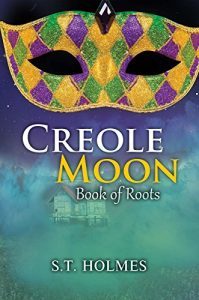 Creole Moon: Book of Roots by S.T. Holmes:
Creole Moon: Book of Roots by S.T. Holmes:
Mardi Gras in New Orleans is the perfect locale for a treasure hunt. When it coincides in the year of the Luperci festival, the magic world is turned upside down, and the feast of forgiveness turns into a fight of wickedness. This Mardi Gras festival is like non ever seen before or will ever see in the future.
Experience sibling rivalry at its finest as two sisters square off against each other for control of the book of roots. Unite with our hero, George Genois, as he is drawn deeper into the realm of magic and the forces of good and evil. If he thought his adventures with Mamuska and Ophelia were harsh before, then he is in for an even wilder time with these sisters. Each sister wants him as an ally, but George is interested in righting a wrong done only to him. Does George get his revenge?
 A Rose at Midnight by Sylvie Kurtz:
A Rose at Midnight by Sylvie Kurtz:
He abandoned her to save her life. Now he must convince her he still loves her before the stroke of midnight on Mardi Gras . . . or condemn her to her death.
Nine years ago, Christiane Lawrence fell hard for a mysterious young music student. Even after he left her without a goodbye, the memory of Daniel Moreau haunts Christi every day when she looks at their daughter’s face.
Whenever Christi asked about her mother’s family, she was warned to stay away from the birthplace her mother fled. Now, grieving her parents’ death in a car accident, an invitation from Gabriel Langelier, a cousin she’d never met arrives, promising answers. This is her chance to give her daughter a taste of the family roots she never had.
What Christiane doesn’t know is that her mother’s warning sprang from real fear. Gabriel is obsessed with the legend of Rose Latulippe. He’s sure only someone from Christiane’s bloodline can fulfill his quest for eternal life. He must have her heart at midnight on Mardi Gras.
To save the woman he loved, Daniel made a bargain with the devil and abandoned her without explanation. And now she’s back in the middle of danger, bringing their daughter with her.
To have a second chance and earn Christiane’s forgiveness, Daniel has to convince Christi he still loves her before the stroke of midnight on Mardi Gras . . . or send her to her death.
 Voodoo Dreams by Alana Lorens:
Voodoo Dreams by Alana Lorens:
When her big trial goes bad, corporate attorney Brianna Ward can’t wait to get out of Pittsburgh. The Big Easy seems like the perfect place to rest, relax, and forget about the legal business. Too bad an obnoxious–but handsome–lawyer from a rival firm is checking into the same bed and breakfast.
Attorney Evan Farrell has Mardi Gras vacation plans too. When he encounters fiery and attractive Brianna, however, he puts the Bourbon Street party on hold. He’d much rather devote himself to her–especially when a mysterious riddle appears in her bag, seeming to threaten danger.
Strangely compelled to follow the riddle’s clues, Brianna is pulled deeper into the twisted schemes of a voodoo priest bent on revenge. To escape his poisonous web, she must work with Evan to solve the curse. But is the growing love they feel for each other real? Or just a voodoo dream?
 Battlefield Z: Mardi Gras Zombies by Chris Lowry:
Battlefield Z: Mardi Gras Zombies by Chris Lowry:
He found them!
Two of his three children are alive and now that he’s found them he won’t let them out of his sight.
It’s time to find his youngest daughter.
The last he knew she was heading to a refugee camp with her Mom and step-dad. He’s got a map of the camps back at Fort Jasper waiting.
All he has to do is keep his kids safe as they search for answers and a trip back to Alabama. The safest route floats them down the river. It keeps the Z at bay, but delivers them straight into a fortress that feels like paradise.
He has a choice. Hide behind the walls with two thirds of his heart and let the world burn or take a chance and continue the hunt.
An easy job if it weren’t for all the damn zombies.
 The Outer-Universe Cruise Ship Mardi Gras by E. Miguel:
The Outer-Universe Cruise Ship Mardi Gras by E. Miguel:
Space, there is a lot of it. Like really, a lot. As much space as there is though, it also happens to be very crowded. It is for this exact reason the Outer-Universe Cruise Ship Mardis Gras was created. While other cruises throughout the universe offer excitement and adventure, the Mardis Gras offers the mundane for those vacationers that are allergic to such excitement and adventure. The ship’s only constant inconstant is a Mardis Gras party held every other day.
Unfortunately for two passengers on the ship, this week’s cruise offers more than they signed up for. Escape pods, a slumbering Old God, and a Voodoo priestess robot all happen to show up on the unplanned itinerary this week.
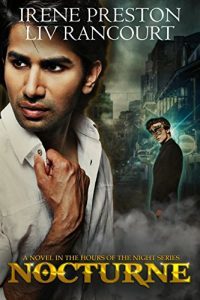 Nocturne by Irene Preston and Liv Rancourt
Nocturne by Irene Preston and Liv Rancourt
It’s Mardi Gras, cher, but this year le bon temps kick off with murder…
For generations, the White Monks have treated the vampire Thaddeus Dupont as a weapon in their battle against demons. However, when a prominent matron drops dead at a party, Thaddeus and his lover Sarasija are asked to find her killer. Their investigation leads them to an old southern family with connections everywhere: Louisiana politics, big business, the Church, and an organization just as secret as the White Monks.
Meanwhile, an esoteric text containing spells for demon-summoning has disappeared, Thaddeus is losing control of le monstre, and Sara is troubled by disturbing dreams. These nightmares could be a side-effect of dating a vampire, or they could be a remnant of his brush with evil. As the nights wear on, Sara fears they are a manifestation of something darker – a secret that could destroy his relationship with Thaddeus.
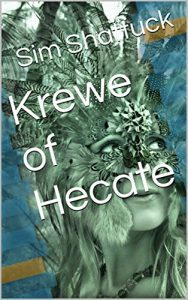 Krewe of Hecate by Sim Shattuck:
Krewe of Hecate by Sim Shattuck:
A group of Mardi Gras wizards descend to the Underworld and capture the goddess Hecate so that they can display her during Carnival. But they didn’t understand that having the goddess of the Uncanny upon the face of the Earth would do to three unlucky New Orleans residents.
 Burgundy Doubloons by T.J. Spencer Jacques:
Burgundy Doubloons by T.J. Spencer Jacques:
You caught a doubloon at a Mardi Gras Parade – that was a bad thing.
Trent McGowan is going home. Home to his ailing mother. Home to the city of his childhood. Home to New Orleans. As Trent deals with the peculiar circumstances surrounding his mother’s illness, his family gets swept up in the excitement of Mardi Gras and all of the festivities of that intoxicating day. The jubilant crowds, breathtaking carnival floats, and oh yes, the throws! His youngest daughter Zoe catches one of those throws, a sparkling red doubloon, and that is where the story ends and begins.
Burgundy Doubloons is more than just a suspense thriller, it is everything that makes New Orleans the party capital of the world: only bloodier and darker.
For those who love a parade, Burgundy Doubloon answers a terrifying question: What if your child simultaneously caught a bead, and a murderous spirit? In this heart-palpating novel, you will meet the entire McGowan family, and the people determined to destroy them.
Finally, a paranormal thriller that takes place in New Orleans – as told by a native son who knows where the bodies are buried.
 Poison and Wine by C.H. Valentino and Eldon Hughes:
Poison and Wine by C.H. Valentino and Eldon Hughes:
Welcome to the Crescent City
Danni Toussaint has a nail in her chest as a mark of her debt to The Baron Samedi – a debt she can only repay with the souls he forces her to steal.
Michael Belew is desperate. Someone is kidnapping nuns in the Ninth Ward where he was raised an orphan, and he suspects a powerful enemy armed with voodoo magic.
When Michael asks for Danni’s help to find the kidnapper – or killer – they become pawns in a vicious game between The Baron Samedi and his brother, Lacroix.
The prize? Control of the most powerful source of magic in New Orleans.
Now, to protect the people of his city and save Danni from Samedi, Michael may have to sacrifice his soul.
 Razor Valentine by Roland Yeomans:
Razor Valentine by Roland Yeomans:
MARDI GRAS … MAGIC … MURDER
In 1947 New Orleans THREE KINGS DAY marks the start of the official Carnival Season. Carnival, coming from the Latin words, carne vale, meaning “farewell to the flesh.”
Nuestra Señora de la Santa Muerte, Our Lady of Holy Death, is stalking the French Quarter streets killing apparently at random. What does the psychotic actress, Irene Dupré, know of this entity and what lies behind the murders? She remains silent, only smiling. Santa Muerte’s strange acolyte lurks in the shadows watching, waiting. Waiting for what?
Frank Capra is filming a historical fantasy in the city with Jimmy Stewart, Cesar Romero, and the enigmatic Irene Dupré. Former O.S.S. operative, now the film’s Prop Master, Lucas, finds himself in the middle of the mystery with more questions than answers.
His lost love back from the dead, Ingrid Durtz, and his best friend, Mitchell Mack, are at a loss on how to stay alive, much less catch a supernatural killer.
Then, there is Lucas’ former O.S.S. team mate, Father Darael, whose gift of a Seraph Blade is literally a two-edged blessing. You see, Darael is a Seraphim Provocateur. And Lucas is unsure whose side he is really on, the Celestial or the Fallen?
 Send to Kindle
Send to Kindle
February 23, 2020
Retro Review: “The Veil of Astellar” by Leigh Brackett
There are space vampires, but no space walrusses in this story.
“The Veil of Astellar” by Leigh Brackett is a space opera novelette, which appeared in the spring 1944 issue of Thrilling Wonder Stories and is therefore eligible for the 1945 Retro Hugos. The magazine version may be found here. This review will also be crossposted to Retro Science Fiction Reviews.
Warning: There will be spoilers in the following!
Uncommon for Leigh Brackett, “The Veil of Astellar” begins with a framing story about a manuscript found inside a message rocket sent to the Interworld Space Authority headquarters on Mars. This manuscript offers an explanation of the space phenomenon called “the Veil” which comes out of nowhere and swallows spaceships in the asteroid belt. The space police officers are initially sceptical about the account, but eventually manage to determine that it is authentic. Furthermore, the much feared Veil has vanished and the message inside the rocket explains why.
Once the framing story is out of the way, Leigh Brackett takes us to one of her favourite locales, the low-canal town of Jekkara on Mars, a wretched hive of scum and villainy to quote Obi-Wan Kenobi. Here we meet the first person narrator – unnamed for now, though we will eventually learn that his name is Steve Vance – stumbling over a corpse that has been thrown out of a Martian brothel. The corpse clearly bothers the narrator, though he did not kill the man, and so he closes the dead man’s eyes.
Once he’s done, he meets a young couple – Virgie, a redhead who reminds the narrator of his dead wife Missy, and her husband Brad. Brad and Virgie are passengers aboard a space liner called the Queen of Jupiter, which is carrying immigrants to the Jovian colonies. Vance serves aboard the same ship – quell coincidence. We also learn that Vance is telepathic, that he has a glowing aura, which responds to his emotions, as well as white hair, even though he does not look old.
Virgie is troubled by the dead body in the street and also by Vance, who she claims looks familiar. Vance says that they probably met aboard the Queen of Jupiter and tells Brad and Virgie to return to the ship where it’s safe. Then, after a tastefully described pit stop at a Martian brothel, he heads back to the ship himself and has another encounter, this time with a man called Gallery, a fellow crewmember aboard the Queen of Jupiter. Gallery is yet another of the Irish stereotypes I’ve encountered several times before in the course of the Retro Reviews project. And so Gallery is a big quick-tempered brawler who smells of whiskey. Though unlike the redheads Mike Donovan from Isaac Asimov’s “Catch That Rabbit” and Steve “Irish” Marnagan from Ray Bradbury’s “The Monster Maker”, Gallery has black hair, which must count for something. I already knew before I embarked on the Retro Reviews project that Irish stereotypes were a thing during the pulp era and well beyond (Star Trek: The Next Generation featured several in the late 1980s/early 1990s), but it was still a surprise to encounter three of them in such a short span of time.
Though Gallery adds a new item to the list of pulp era stereotypes about the Irish, for he also happens to have extra-sensory perception, which – so Vance informs us – you occasionally find, particularly among humans of Celtic and Romani origin. Yeah, more stereotypes, but at least Brackett uses the term “Romani” rather than the more common slur. Gallery’s touch of ESP is a problem for Vance, because Gallery has perceived that something is off about him. “You ain’t human,” Gallery confronts Vance who replies, “No, not anymore. Not for a very long time.”
Gallery is planning to kill Vance. To make sure, he has even brought two silver crucifixes, one for each hand. Vance informs Gallery that the crucifixes won’t help, because he’s not that kind of vampire, but Gallery is undeterred. So Vance kills him by telepathically stopping his heart. He hides the corpse in a ruined tower (there are a lot of those on Leigh Brackett’s dying Mars) and returns to the Queen of Jupiter.
Now anybody who knows anything at all about astronomy knows that in order to get from Mars to Jupiter, you must first pass through the asteroid belt. And from the framing story, we know that spaceships have been vanishing in the asteroid belt. So we don’t really need a chapter title like “Voyage of Doom” to know where the story is going.
And indeed, as the Queen of Jupiter hits the asteroid belt, Vance is on watch, while the passengers crowd around the portholes. Rumours are traded about the Veil and how it snatches ships and how it’s all absolutely true, because one passenger’s brother saw it from a distance once, while it took the spaceship upon which the son of another was serving.
Virgie and Brad reappear as well and Vance is mesmerised not just by Virgie’s resemblance to his dead wife, but also by her locket. Noticing his interest, Virgie opens the locket which contains an photo of a man who looks uncannily like Vance. The locket is more than three hundred years old, Virgie tells him, a family heirloom and was a present by an ancestor of hers, a crewman aboard the first spaceship to Jupiter, to his wife Missy. Unbeknownst to her husband, Missy was pregnant, when he left for Jupiter, never to return. The locket has been in the family ever since.
Vance is stunned, for not only does he wear an identical locket under his uniform, he is also Virgie’s long lost ancestor, who vanished during that first flight to Jupiter. But before Vance can say anything, the feared Veil appears and everybody aboard the Queen of Jupiter falls unconscious. That is, everybody except for Vance.
The Queen of Jupiter finally reaches her destination, a world called Astellar that looks outwardly like just another asteroid, is half the size of Vesta and can travel not just through space, but between dimensions as well, all powered by telepathy and something called X-crystals. In fact, Astellar and its people were expelled from their home dimension for reasons which will soon become apparent.
On Astellar, the passengers and crew of the Queen of Jupiter disembark as if in a trance, drawn by a telepathic signal. Vance disembarks as well and meets first Flak, a man of colour who also was a crewman aboard a snatched spaceship, and then his alien lover Shirina.
Gradually, we learn what happened to Vance. His ship was taken by the Veil and brought to Astellar. Shirina and her people normally drain the lifeforce out of the crew and passengers of the ships they snatch to rejuvenate themselves – which is why they were expelled from their home dimension, because no one likes space vampires. However, they decided to keep Vance, Flak and three other humans alive and changed them into beings like themselves, immortal as long as they regularly rejuvenate themselves with the stolen lifeforce of others. Then Shirina and her people used Vance, Flak and the others to lure more spaceships to Astellar and more humans to the slaughter. And Vance and the others went along with it.
Vance has clearly been feeling guilty of what he’s been doing for Shirina and her people for a long time now, but he is too afraid of dying because of the many sins he committed and the many deaths he caused in his long life. But something is different now. Now Vance knows that he had a daughter, a family, and that Virgie is his descendant. And even though Shirina assures him that Virgie’s death will be painless, that they will all die painlessly, Vance cannot take it anymore. He takes off, determined to save his several times great-granddaughter and the other humans.
Flak and the other altered humans block his way, but Vance kills all of them. He reprograms the X-crystals to send the hypnotised humans back aboard the Queen of Jupiter. Then he kills Shirina and destroys the crystals, which causes Astellar to break apart. Vance manoeuvres the Queen of Jupiter out of the docking bay, before the asteroid is completely destroyed. Finally, he activates the autopilot, sets a course for Jupiter, boards a lifeboat and leaves. At last, he sends the message mentioned in the framing story, a message which ends with Vance cursing himself for betraying both humanity as well as Shirina’s people and causing the deaths of his friends and his lover. And he’s not even sure if humanity is worth saving or if it was worth killing the people of Astellar for.
“Why did I give Missy that locket?” he writes, “Why did I have to meet Virgie, with her red hair? Why did I remember? Why did I care? Why did I do what I did? Why was I ever born?” Neither we nor Vance ever get answers to those questions, unless an ad for Star Razorblades counts as an answer. If so, it’s a depressing one.
[image error]During her lifetime, Leigh Brackett was known as the Queen of Space Opera, even though most of what she wrote was actually planetary romance. “The Veil of Astellar”, however, is pure space opera. It’s also a fine example of the noir side of Brackett’s work and the guilt-ridden and self-loathing Steve Vance is a classic noir protagonist, even if he is a vampire. Even the first person narration, uncommon for Brackett, recalls the hardboiled crime novels of the era. In his review of this story, Adventures Fantastic says that Leigh Brackett’s husband Edmond Hamilton believed that Humphrey Bogart was the inspiration for Steve Vance. And indeed, there is something Bogartesque about the voice Brackett gives Vance.
Steve Vance is another outlaw protagonist with a kernel of goodness buried somewhere deep inside his hard shell. This was a character type Brackett obviously liked and frequently wrote about, both in her science fiction and her filmic work. But while Leigh Brackett’s other outlaw protagonists are thieves, small-time criminals, mercenaries or revolutionaries, Vance is a literal space vampire. With his guilt, world-weariness and self-loathing, Vance is also a protagonist who would never have found a home in John W. Campbell’s Astounding, even if his residual humanity is what allows him to triumph over the alien space vampires in the end.
In my review of Leigh Brackett’s “Terror Out of Space” I wrote that it was a comparatively rare example of the horror side of Leigh Brackett’s work. However, “The Veil of Astellar”, which was published in the same year, is another science fiction horror story by Leigh Brackett. But while “Terror Out of Space” was clearly inspired by Lovecraft, “The Veil of Astellar” is a classic vampire story transposed into outer space.
As far as I know, “The Veil of Astellar” is the first space vampire story, published thirty-two years before Colin Wilson’s novel The Space Vampires and forty-one years before its film adaptation Lifeforce. And indeed, “The Veil of Astellar” bears certain similarities to The Space Vampires. In both stories, the space vampires lurk in the asteroid belt, where a hapless spaceship stumbles upon them, both vampire races have been expelled from their original homes, both Wilson’s and Brackett’s space vampires drain the lifeforce rather than the blood of their victims and both are eventually defeated by a human who has learned their powers. I don’t know if Colin Wilson ever read “The Veil of Astellar”, but the parallels are certainly striking. Though Wilson has admitted that The Space Vampires was strongly influenced by the works of H.P, Lovecraft, who was of course also an influence on Leigh Brackett.
There also are some similarities to another Leigh Brackett story from the same year that I reviewed, “The Jewel of Bas”. Both stories feature world-weary and depressed immortals who eventually turn on their own comrades, though Steve Vance is the protagonist of “The Veil of Astrellar”, while Bas from “The Jewel of Bas” is merely a supporting character. Furthermore, both stories contain a tense scene of hypnotised humans going unknowingly to their doom and in both, the protagonist tries to save a woman he cares for. Though Ciaran tries to save his newlywed wife Mouse, while Steve Vance tries to save his descendant Virgie who looks uncannily like his dead wife.
“The Veil of Astellar” also contains something else one rarely finds in the US pulp science fiction of the golden age, namely explicit references to Christianity, whether it’s Gallery and his two crucifixes or Vance introducing himself as J. Goat – J for Judas – or Vance fearing God’s wrath and hoping that someone somewhere will pray for him.
Contrary to what certain Sad and Rabid Puppy offshoots claim, there is very little religion, let alone Christian religion, to be found in the American pulp science fiction of the golden age, probably because many of the writers were secular Jews or equally secular Christians. Explicitly Christian works of the era, such as the Space trilogy by C.S. Lewis, come from outside the pulp science fiction scene. But in American science fiction magazines of the golden age, religion – if it is mentioned at all – is either a) a sham, b) for aliens or c) both and you are far more likely to find a reference to Cthulhu than to the Judeo-Christian God.
And so, religion usually plays no role in Leigh Brackett’s science fiction of the 1940s (religion does play a role in her 1955 post-apocalyptic novel The Long Tomorrow, though not a positive one). There are the occasional ancient Martian and Venusian cults, which sometimes turn out to be a sham and sometimes not, but Brackett’s protagonists are normally not religious. However, Christianity is baked into the western vampire mythos on which Leigh Brackett is drawing for this story and so religion does figure into “The Veil of Astellar”.
[image error]Like any story by Leigh Brackett, “The Veil of Astellar” is well written and dripping with atmosphere. The scenes in Jekkara and aboard the spaceship carry a heavy noir vibe, while the descriptions of the interior of Astellar are positively psychedelic, even though the story was written before the term “psychedelic” was even coined.
Leigh Brackett is undoubtedly one of the finest authors of the golden age and was also highly influential on anything from Star Wars (and not just because she wrote an early draft of the screenplay for The Empire Strikes Back either) via Indiana Jones (there are several Leigh Brackett stories from the 1940s, which are basically Indiana Jones in space) to Guardians of the Galaxy. In fact, Shirina from “The Veil of Astellar” is pretty much a femme fatale version of Mantis from Guardians of the Galaxy down to the antennae.
Nonetheless, Leigh Brackett is not always as appreciated as she should be, maybe because she fits in nobody’s pigeon hole. She did publish a few stories in Astounding, but she never wrote Campbellian science fiction. Instead, Leigh Brackett’s stories are unabashed pulp science fiction, filled with adventure, intrigue and morally grey outlaw protagonists who are a lot more interesting than the competent cardboard cut-outs of Astounding.
Leigh Brackett is also one of the two female SFF writers of the golden age (the other is C.L. Moore) who are always held up as an example that women were always part of the genre, even as other women writers of the period such as Allison V. Harding, Clare Winger-Harris, Leslie F. Stone or Dorothy Quick are forgotten. But while Leigh Brackett is one of the poster girls for women writing SFF during the golden age, there is nothing particularly feminine about her stories. Her heroes were usually macho types, who often engage in hate-love relationships with sword, axe or whip-wielding women who want to kill them. And while there always are notable female characters in her stories, a lot of them are femme fatales. Besides, very few of Leigh Brackett’s stories pass the Bechdel test.
Politically, she’s all over the map as well. The Sad and Rabid Puppies, particularly the Pulp Revolution offshoot thereof, have tried to claim her for their own, but a lot of Brackett’s stories from the 1940s are highly critical of capitalism and colonialism and occasionally read like the very social justice warrior fiction they Puppies claim to dislike. On the other hand, her late period Skaith trilogy features evil hippy and evil space socialists trying to keep honest, hardworking barbarians from escaping their doomed planet.
But even though Leigh Brackett doesn’t really fit into anybody’s pigeon hole, one thing you can always be sure of is when reading one of her stories is that you’ll be having a good time. There are Leigh Brackett stories I like more than others, but I’ve never yet read a Leigh Brackett story I didn’t like. And while Leigh Brackett is mainly associated with her Martian adventures and Eric John Stark these days, the breadth and scope of what she wrote is much bigger. In 1944 alone, we have Lovecraftian space horror (Terror Out of Space), lyrical planetary romance (“The Jewel of Bas”), noirish gothic horror space opera (“The Veil of Astellar”) and social justice warriors of Mars (“Shadow Over Mars” a.k.a. “Nemesis from Terra”), which will be the subject of an upcoming review.
“The Veil of Astellar” feels very much as if Weird Tales and Black Mask (home of many classic noir and hardboiled tales) had a baby and decided to foster it at Thrilling Wonder Stories. It’s also a fine example of how the speculative fiction of the golden age was so much more varied, weirder and stranger than just the competent engineers of Astounding. Highly recommended.
 Send to Kindle
Send to Kindle
Masks and Murder 2020 – A Round-up of Indie Mardi Gras Mysteries

Our monthly round-ups of new speculative fiction and new crime fiction releases by indie authors are a perennially popular feature. Therefore, we now offer you a round-up of our favourite Mardi Gras mysteries, crime novels and thrillers by indie and small press authors.
The holiday mysteries cover the broad spectrum of crime fiction. We have cozy mysteries, hardboiled mysteries, small town mysteries, big city mysteries, paranormal mysteries, historical mysteries, crime thrillers, legal thrillers, psychological thrillers, medical thrillers, paranormal thrillers, YA thrillers, private investigators, amateur sleuths, ghost whisperers, crime-busting nuns, crime-busting beauty queens, lawyers, serial killers, missing children, murdered fathers, missing mothers, missing masks, faked suicides, cursed doubloons, poisoned king cakes and much more. But one thing unites all of those very different books. They’re all set on or around Mardi Gras.
As always with my round-up posts, this round-up of the best indie holiday mysteries is also crossposted to the Indie Crime Scene, a group blog which features new release spotlights, guest posts, interviews and link round-ups regarding all things crime fiction several times per week.
As always, I know the authors at least vaguely, but I haven’t read all of the books, so Caveat emptor.
And now on to the books without further ado:
 Krewe of Souls by Elaine Calloway:
Krewe of Souls by Elaine Calloway:
Mardi Gras, Mayhem, and Murder…
Tristan Pleasance is a ghost whisperer extraordinaire, but talking to his living father is another story. Family conflict prompts Tristan to bolt from his lifelong home in St. Francisville, Louisiana, to make a new life in New Orleans. But six months later, a family tragedy forces him to return home and he is thrust into a murder investigation where his past and future will collide.
Grace Lansing is a New Orleans columnist who yearns to write feature articles rather than puff pieces. To prove herself to her editor, she travels to the quaint town of St. Francisville to research their big Mardi Gras Krewe competition. But what seems an innocent cultural practice quickly turns into a web of intrigue—and getting too close to the handsome Tristan puts her in danger of becoming collateral damage.
Together, Tristan and Grace must find out who is responsible for the murders—before the Krewe of Souls is trapped forever.
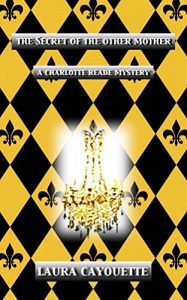 The Secret of the Other Mother by Laura Cayouette:
The Secret of the Other Mother by Laura Cayouette:
It’s late 2009 and the Saints are undefeated on their way to the Super Bowl. Fresh off the Los Angeles red carpet of the movie she produced and starred in, vivacious Charlotte Reade heads to her family home in New Orleans for the funeral of Sassy, the woman who helped raise her mother.
When Sassy’s “adopted” twin daughters ask brainy and tenacious Charlotte to help them find their birth mother, she heads down a path that starts in a laundromat in the 1950’s and winds through costume experts and a burlesque tour before landing her on the infamous Bourbon Street.
Along the way, Charlotte reconnects to her own family history, uncovering clues to a family secret and the ghost who’s said to protect it. As her funeral trip extends through the Super Bowl and Mardi Gras, Charlotte struggles with her dedication to the career she worked so hard for and the intoxicating draw of the culture, romance and soul of the city she’s always wanted to call home.
 Izzy Rio’s Wild and Pretty by Stacey L. Cooley:
Izzy Rio’s Wild and Pretty by Stacey L. Cooley:
When I was five years old, my father was murdered on Lundi Gras Day in New Orleans, Louisiana. That moment in time began a journey that changed my life forever. After that devastating day, my mother could not bear to live in New Orleans anymore. Against my grandfather’s wishes, she took me away with her to live in Rio de Janeiro with my father’s family. For ten years, we traveled together around the Caribbean, Central and South America visiting the Carnival People and trying to forget what we lost. My mother was looking for clues and a reason for my father’s unexpected death.
Just when you thought you knew New Orleans, I am back!
They say Mardi Gras Day is a time to forget all of your troubles.
Here is what happened on my Mardi Gras Day:
I lost the person that was closer to me than anyone else.
I was supposed to mask for the first time as a Mardi Gras Indian Princess . . .
But, I ended up on the run and fighting for my life.
I learned more about the Backstreet Carnival Culture than I ever wanted to know.
In order to survive, I must train and learn the art of being a Mardi Gras Indian.
Welcome to Carnival Time.
You will never be young again!
I AM IZZY RIO.
Street kids are disappearing, but how do you report that to the police when, from their standpoint, the missing people didn’t exist to begin with? Hustle is certain that something bad has happened to his friend Jinx, and the only person he can turn to for help is private investigator Shaye Archer. Because Hustle helped the young PI while she was investigating her first case, Shaye has already formed an opinion as to his character and believes he’s telling the truth. As she digs deeper into Jinx’s disappearance, she discovers that Hustle’s friend isn’t the only one missing. As a frightening pattern emerges, Shaye wonders if she can find the missing kids…before it’s too late.
 Ms. America and the Naughtiness in New Orleans by Diane Dempsey:
Ms. America and the Naughtiness in New Orleans by Diane Dempsey:
Who better than Ms. America Happy Pennington to grace Mardi Gras festivities in never-say-die New Orleans? She packs good looks, party moves, and sleuthing smarts—which come in handy when the king for an elite old-line krewe is bumped off during a Carnival parade.
All too soon Happy learns the centuries-old French Quarter is not all jazz, Creole cuisine, and cocktails: evil lurks there, too, even amid the pageantry of the Big Easy’s most gleeful season. Yet no ghost, vampire or even voodoo spirit will keep our scrappy beauty queen from nabbing the killer—not when the stakes are sky-high for someone near and dear to her heart.
Find out why readers call the Beauty Queen Mysteries “super-fun reads” they can’t put down until the last page is turned …
 Mardi Gras Murder, edited by Sarah E. Glenn:
Mardi Gras Murder, edited by Sarah E. Glenn:
Thirteen tales of crime set during the bacchanalia that is Mardi Gras. Featuring stories from Harriette Sackler, Marian Allen, Debra H. Goldstein and Nathan Pettigrew. The mayhem of Mardi Gras is served with a healthy dose of Cajun dishes and an unhealthy number of deaths. Dig into Bourbon Street Lucifer, Voodoo Honeymoon, a dish of Red Beans and Ricin, and other deadly treats.
 Mardi Gras Madness by Alison Golden and Honey Broussard:
Mardi Gras Madness by Alison Golden and Honey Broussard:
A timid traveler. A New Orleans adventure. A Mardi Gras murder…
Roxy believed that life never gives you more than you can handle. But when she’s fired from her wage-slave job, bullied by her co-workers, and her boyfriend abandons her, she decides she’s handled quite enough. Eager for a change of scene, Roxy with her white Persian cat Nefertiti head off to New Orleans.
The exotic sights, smells, and food of Mardi Gras coax the shy young woman out of her shell. Booking a room at a rundown guesthouse, Roxy is surrounded by a colorful cast of local characters. From tattooed waitresses to mystical tarot card readers, she quickly makes new friends and leaves her old life behind.
But she soon discovers that the Big Easy isn’t all beignets and jambalaya. A wealthy developer is eager to buy the guesthouse where Roxy lives and tear it down… until he turns up dead as a doornail! Before she can say ‘Mon Dieu!’, Roxy is caught up in a diabolical murder mystery… and her new friends are the prime suspects!
Roxy is determined to protect her pals, and save her new home. But is this anxious adventurer up to the challenge of solving a murder? Or will she become the killer’s next victim…
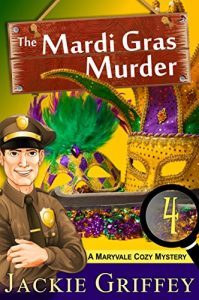 The Mardi Gras Murder by Jackie Griffey:
The Mardi Gras Murder by Jackie Griffey:
Like bananas, Sheriff Cas Larkin’s troubles are ripening in bunches.
A fully dressed woman is found drowned in the lake. He has a citizen no one can find, but hasn’t been reported as missing and all of her known acquaintances are standing in the way of Cas’s investigation. Then Judge Carpenter’s fiancée lands in jail, accused of a bloody murder way down yonder in New Orleans!
Now Cas must pick up the pace and connect the dots… before he goes bananas himself.
 Murder at the Mardi Gras by V. Hurst:
Murder at the Mardi Gras by V. Hurst:
The Bryans and the Flannerys from ‘Murder at the JC’ and ‘Murder on the Cruise Ship’ take a vacation in New Orleans during Mardi Gras Season. They are soon recruited by their old friend FBI Special Agent Don Hobbs to search for a serial killer who murders a young woman each Mardi Gras for her kidneys. Clues lead the foursome to the killer and to a huge twist at the end of the story.
 Murder at the Mardi Gras by Linda P. Kozar:
Murder at the Mardi Gras by Linda P. Kozar:
When an esteemed professor of Louisiana history is found face down in a King Cake, young detective Annie Fournier suspects foul play and begins an investigation to find the person responsible. Her partner has little patience for Annie’s inexperience or gender and seems to enjoy mocking her at every opportunity. And to top that off, the crazy melee of Mardi Gras seems to hamper their progress at every turn. Will they weigh in on the identity of the murderer before Fat Tuesday ends, and will Annie prove that she has what it takes to be a detective?
My name is Eugene Doyle Babineaux, Krewe to my friends. I’m a private investigator in Sacramento, California. My life is unassuming, and I like it that way. Things changed when I received a call from my brother. My mom was dead–suicide, he says. I didn’t believe it for a minute. So, I returned home to New Iberia, a small town in southern Louisiana, to look into Mom’s death. Once there, I reunited with old friends and foes alike. It seemed there were nefarious forces who did not want me poking around into Mom’s death. Rich people who keep company with bad people and who would stop at nothing to keep their plans hidden. What do Mardi Gras krewes, sugarcane production, and mob enforcers have to do with my mom’s death? I was about to find out, and things would never be the same.
 Voodoo Dreams by Alana Lorens:
Voodoo Dreams by Alana Lorens:
When her big trial goes bad, corporate attorney Brianna Ward can’t wait to get out of Pittsburgh. The Big Easy seems like the perfect place to rest, relax, and forget about the legal business. Too bad an obnoxious–but handsome–lawyer from a rival firm is checking into the same bed and breakfast.
Attorney Evan Farrell has Mardi Gras vacation plans too. When he encounters fiery and attractive Brianna, however, he puts the Bourbon Street party on hold. He’d much rather devote himself to her–especially when a mysterious riddle appears in her bag, seeming to threaten danger.
Strangely compelled to follow the riddle’s clues, Brianna is pulled deeper into the twisted schemes of a voodoo priest bent on revenge. To escape his poisonous web, she must work with Evan to solve the curse. But is the growing love they feel for each other real? Or just a voodoo dream?
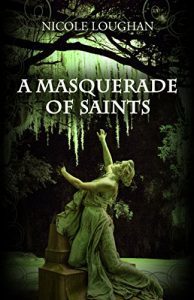 A Masquerade of Saints by Nicole Loughan:
A Masquerade of Saints by Nicole Loughan:
In the third installment in the best-selling Saints Mystery Series small town Cajun, Fanchon, finds herself in some hot water, along with a few nasty crayfish. The heat gets turned up when she receives an invitation to join New Orleans high society. She’s ready to party until she receives a puzzling message from her favorite psychic to stay alert and wash her hands all night. When the warning seems all but forgotten the phone rings and Fanchon learns she should have been more careful. This adventure takes Fanchon from the bayou to the top of the floats at Mardi Gras with new characters and old friends to help along the way.
 Chaos at Crescent City Medical Center by Judith Lucci:
Chaos at Crescent City Medical Center by Judith Lucci:
A New Orleans Attorney’s Mardi Gras Takes A Bloody Turn
Alex wanted a new life, but that often seemed out of reach as long as she was still tied to the same hospital as her ex-husband. Mardi Gras Season brought a welcome change in pace, and her upcoming date to the Mardi Gras Ball with art historian, Mitch Landry, was a step in the right direction. However, when she is called to a grisly scene at the hospital her plans are upended.
A Chilling Scene That Leads Deep Into New Orleans’ Underworld
The Wife of Louisiana’s Governor is discovered unconscious and covered with blood. This shocking scene leads Alex deep into unexpected circles of New Orleans, such as the local criminal underworld and the Voodoo culture.
Chaos at Crescent City Medical Center is a gripping Medical Thriller that will chill and surprise at every turn. You won’t want to put it down!
 The Gay Mardi Gras Murders by Sylvia Massara:
The Gay Mardi Gras Murders by Sylvia Massara:
Mia Ferrari, smartarse, older chick, super sleuth, is back in her 2nd murder mystery and this time, she is up to her neck in drag queens, a rare diamond with a curse and murder most foul against the backdrop of Sydney’s world famous Gay Mardi Gras.
A female impersonator is found dead in her hotel suite bathtub and a rare diamond worth twenty million dollars is gone. The Gay Mardi Gras is fast approaching and Mia Ferrari, senior duty manager of the exclusive Rourke International Hotel Sydney, has to juggle a bunch of drag queens, a number of fabulously handsome gay men, a transsexual with a dark mystery, a young cop with sex on his mind, a close friend from the UK who is having marital problems and a mounting body count.
As Mia pits her investigative skills against her archenemy, Detective Sergeant Phil Smythe to solve the case, she not only becomes embroiled in the life of the people around her, but it looks like she is the next target for a serial killer with a grudge against gay men.
 Mardi Gras Madness by Ken Mask:
Mardi Gras Madness by Ken Mask:
While trying to free a lawyer friend convicted of a crime he didn’t commit, New Orleans private investigator Luke Jacobs is drawn into an international web of real estate fraud, pharmaceutical corporation misdealing and murder. Mardi Gras may have to be put on hold.
 Mardi Gras Gris Gris by A.C. Mason:
Mardi Gras Gris Gris by A.C. Mason:
Susan Foret is thrust into a murder scene when one of the town’s wealthiest citizens dies near her as the local Krewe’s parade is ending. A gris-gris bag containing tarot cards and several other fetish items is left dangling from the knife in his chest.
 Rescued by a Kiss by Colleen Mooney:
Rescued by a Kiss by Colleen Mooney:
All the fun of Mardi Gras—without the hangover!
New Orleans is a big, small town where everybody knows someone you know. They will see what you do and talk about it. It’s hard to steal a kiss at Mardi Gras and not be the topic of local gossip, especially if the man you kissed got shot at the end of the parade…
Colleen Mooney’s humorous, romantic, delightfully meandering cozy mysteries gua-ran-tee you gon’ have a authentic N’ Awlins experience, dawlin’! And a wild ride into the bargain.
Brandy Alexander’s the real deal–yes, that’s her real name and she’s not even a stripper, she’s an amateur sleuth, although her best friend Julia is.
Quirky characters are the norm in a town like New Orleans where anything can happen.
Living up to the family name comes with a price.
When Felix is told his big brother committed suicide by throwing himself under a train, his gut screams foul play. But as the Mardi Gras season descends on the Big Easy, no one is interested in the conspiracy theories of a drug-addled rich kid.
Except, perhaps, one Carnival organization in particular…
A krewe that hasn’t been heard from in decades.
Felix will need the help of a police detective long past his prime, the family’s honor-obsessed butler, and a massive pork fortune, all in order to find justice for his big brother.
His name, his family, and his very life may hang in the balance.
 Burgundy Doubloons by T.J. Spencer Jacques:
Burgundy Doubloons by T.J. Spencer Jacques:
You caught a doubloon at a Mardi Gras Parade – that was a bad thing.
Trent McGowan is going home. Home to his ailing mother. Home to the city of his childhood. Home to New Orleans. As Trent deals with the peculiar circumstances surrounding his mother’s illness, his family gets swept up in the excitement of Mardi Gras and all of the festivities of that intoxicating day. The jubilant crowds, breathtaking carnival floats, and oh yes, the throws! His youngest daughter Zoe catches one of those throws, a sparkling red doubloon, and that is where the story ends and begins.
Burgundy Doubloons is more than just a suspense thriller, it is everything that makes New Orleans the party capital of the world: only bloodier and darker.
For those who love a parade, Burgundy Doubloon answers a terrifying question: What if your child simultaneously caught a bead, and a murderous spirit? In this heart-palpating novel, you will meet the entire McGowan family, and the people determined to destroy them.
Finally, a paranormal thriller that takes place in New Orleans – as told by a native son who knows where the bodies are buried.
 The Mysterious Masks of Mardi Gras by Connie Trapp:
The Mysterious Masks of Mardi Gras by Connie Trapp:
A 2.5 million dollar Harlequin Mask has been stolen right under everyone’s noses!
It was never out of sight—how could this have happened? The auction was invitation-only, which means only one thing: the thief is among them.
The New Orleans police are on the case, the room where the auction was being held is in lockdown, and no one can leave—not even the Mayor and his wife. Everyone there is a high roller and everyone there is a suspect.
Yet before the police can even begin their investigation, they already have their sights set on a prime suspect…the insider responsible for the distraction that allowed the thief to steal the mask without anyone even noticing. One Jane Dough, of Little Rock…
How in the world did JD get herself into this mess? Follow along as JD struggles to prove her innocence and uncover the real thief…
 Mardi Gras Marathon Murders by Diane L. Twilley:
Mardi Gras Marathon Murders by Diane L. Twilley:
Mardi Gras has come to Galveston Texas, and with it the excitement of a new event, the first ever Mardi Gras Marathon. Gina Malloy, a young journalist, is very involved in the planning of the event. When she enlists the help of her aunt, Sister Catherine Malloy, she is delighted to discover that Sister Catherine’s friend, Martin Iberson, is the agent of one of the big stars of marathon events, Billy Champion. Gina is eager to meet Martin Iberson and his family, and perhaps get a chance to meet and interview Billy Champion.
All goes well, until evil shows its face, and two of the marathon runners are killed. With the help of their friend, police lieutenant Richard Tierney, the nun and her niece embark on the task of finding out who murdered the runners, and as things progress, they find their lives in danger as well. But from whom? And why?
Things become even more somber as they realize that the culprit could be someone they know. Eventually Sister Catherine deduces that to solve the murders she must understand the character of the killer, and she finally comes up with the shocking solution to the Mardi Gras murders.
 The Mardi Gras Two Step by Barry M. Vass:
The Mardi Gras Two Step by Barry M. Vass:
A series of young girls, strippers, are found mutilated and abandoned in the streets and byways of the French Quarter in early 1972. As more bodies turn up, at first in the Mississippi River, and then across the river in Algiers, the detectives assigned to the case are baffled: what sort of deviant could be responsible for such horrific behavior? And then, as the chaos of Mardi Gras crashes in like a wave around them, they begin to suspect that the killer they’re looking for might not even be human…
 Send to Kindle
Send to Kindle
February 20, 2020
Retro Review: “Double-Cross” by James MacCreigh a.k.a. Fredrik Pohl
[image error]“Double-Cross” by James MacCreigh is a science fiction short story, which appeared in the winter 1944 issue of Planet Stories and is therefore eligible for the 1945 Retro Hugos. The magazine version may be found here. This review will also be crossposted to Retro Science Fiction Reviews.
And in case you’re wondering about the author, James MacCreigh was a pen name Frederik Pohl used several times in the 1940s for his solo stories.
Warning: There will be spoilers in the following!
“Double-Cross” takes us once more to the fog-shrouded. swampy and permanently cloudy Venus that never was that is a familiar setting in pulp science fiction published in Planet Stories, Startling Stories, Thrilling Wonder Stories and similar magazines.
The story starts with some exposition heavy dialogue between Lowrey, Officer of the Deck aboard an Earth spaceship, and the Executive Officer who never gets a name. Lowrey remarks that everything is quiet and that he cannot even note anything in his logbook, because nothing is happening.
The Executive Officer is more sceptical, because he doesn’t trust the “natives”. When Lowrey points out that those “natives” are human just like them, descendants of the crew of the first starship to Venus, the Executive Officer declares that they might have been human once, four or five generations ago, but that Venus has changed them into something else. And so the Venusians have pallid white skin due to lack of sunshine and they have no hair either. That’s not how evolution works, at least not that quickly, but then the Executive Officer is something of a bigot.
Lowrey, on the other hand, thinks that the natives are friendly enough. Some of them are hostile, worried that now humans know that Venus is habitable, the planet will be overrun with immigrants from Earth who will displace the original settlers. There is an underground movement as well, which Lowrey dismisses as paltry and unimportant. Though he is not bothered that settlers from Earth will displace the Venusians. After all, survival of the fittest is the basic law of evolution. We suspect that Lowrey doesn’t know how evolution works either. Lowrey’s musings are interrupted, when the sensors detect that a spy ray is aimed at the Earth ship.
If there was a ranking of “As you know, Bob…” scenes in golden age science fiction, Frederik Pohl’s version in “Double-Cross” would rank higher than Isaac Asimov’s various attempts, if only because Pohl’s dialogue is less clumsy than Asimov’s. On the other hand, Asimov gets points for cleverly using an “As you know, Bob…” scene as a vital clue in a mystery in “The Big and the Little” and just making fun of the convention in “Catch That Rabbit”.
It’s also interesting that Pohl’s “As you know, Bob…” scene takes the form of a conversation between two ship officers. Idle conversations about the plot between random guards, soldiers, crewmembers, etc…, who often will never appear in the story again, are a common convention in space opera and military science fiction (and elsewhere) that predates the pulp era by centuries (you can find variations of this scene in Shakespeare plays) and one that still persists to this day. A recent example, played for laughs, was the scene with the two idiotic Stormtroopers who punched Baby Yoda (Boo, hiss) in The Mandalorian.
At any rate, the scene between Lowrey and the Executive Officer does its job of setting up the central conflict between the original settlers of Venus and the newcomers from Earth neatly enough. Any parallels to historical events are entirely coincidental, I’m sure.
The scene then switches to what is going on at the other end of the spy ray, where the Venusian underground has been listening in on the two Earth officers and are now convinced that the worries about immigrants from Earth displacing the Venusians are justified. We meet Svan, leader of the underground, and also learn that the underground has the support of the Venusian council.
Svan is a militant and wants to make sure that the spaceship never returns to Earth. And in order to ensure that the Earth ship never makes it home, Svan has a handy Atomite bomb. He also has a plan how to plant it aboard the ship. Svan and his co-conspirators will go to see the Earth ship like the rest of the town. On the way back, they will feign a car accident to draw away the ship guards, giving one of the conspirators the chance to get close enough to the ship to plant the bomb.
Svan’s followers are a lot less militant than he is. An old man named Toller has issues with the fact that planting a bomb aboard the Earth vessel is essentially murder. And a young woman named Ingra remarks that their ancestors came from Earth, too, and therefore Venusians and Earthpeople are of one blood. Svan rightly points out that according to the Executive Officer aboard the Earth ship, the Venusians aren’t even human anymore.
Because none of Svan’s followers are volunteering to plant the bomb, Svan has them draw lots. Svan draws a blank, but when he looks around, none of his followers announce that they have drawn the lot that makes them the bomber. Therefore, Svan assumes that one of his followers is a coward or worse, a traitor. But if he accuses his followers of treason an cowardice, the traitor will be warned. So Svan quickly marks his own piece of paper, while the others aren’t watching, and announces that he will plant the bomb. Why Svan didn’t volunteer in the first place, especially since it was his plan and he is the most militant of the bunch anyway, remains a mystery.
Svan’s plan hits a not entirely unexpected snag, when he and his party are stopped by a Venusian guard who announces that no one is allowed near the Earth ship anymore, because Svan’s spy ray warned the Earthpeople that there was something afoot. Svan signals to the guard that he is on Council business. But the guard refuses to budge and is not a fan of the Council (which we learn is not an official administrative body, but the name of Svan’s underground group) either, so Svan attacks and kills the man to the shock of his co-conspirators.
The conspirators go forth with their plan. They drop off Svan at some distance from the ship and drive onwards, unaware that Svan has planted a second bomb in the car. Since he can’t trust his followers anymore, he has decided to blow them up, because an explosion will make a much better diversion than a car accident. He does briefly waver, when Ingra kisses him good-bye and wishes him good luck. But then Svan decides that even if she isn’t a traitor, Ingra is weak, so she must die for the cause with the others. This confirms that Svan is a murderous arsehole, in case there was any doubt.
Svan makes his way to the ship and waits for the explosion to draw the guards away, while fingering the lot he has drawn and wondering once again who the traitor might be. As terrorists go, Svan is certainly unlucky. For once more, his grand plan goes awry, when the car unexpectedly returns, driven by the loyal Ingra. Ingra tells Svan to jump into the car, because the dead Venusian guard has been found and both Earthpeople and Venusians are now after them. Svan just screams, “Go away!”, and Ingra and the car and tries to leg it, because he knows that the bomb is about to go off. But he never makes it.
After the explosion, Lowrey and the ship surgeon find the dying Svan. They also find the second bomb and realise that the Venusians were trying to bomb them.
“Poetic justice if I ever saw it,” Lowrey says. Then he notices the piece of paper that Svan is still clutching in death and frowns.
The surgeon asks him what’s the matter, whereupon Svan shows him the piece of paper and notes that it is marked with a cross on both sides. So there never was a traitor – Svan was just too stupid to turn over the paper.
[image error]“Double-Cross” is a neat science fiction thriller with a surprising, if somewhat contrived conclusion. The title (a good title, which I have used a for science fiction story myself) is also doubly relevant, both the in metaphorical (Svan double-crossing his own followers) and literal (there are two crosses on the piece of paper) sense. It also a good example of the twist ending stories that were so popular during the golden age.
Not a lot of stories surprise me these days – I can usually tell where they’re going in a few pages. “Double-Cross”, however, did surprise me. Initially, I was expecting something along the lines of a Leigh Brackett story about a revolt of native people against the invading Earth capitalists similar to the 1944 Retro Hugo finalist “Citadel of Lost Ships” or the later Eric John Stark stories. Never mind that forty years of Star Wars and its imitators have primed us to inevitably assume that the plucky rebels fighting against overwhelming forces are the good guys. But sometimes, the plucky rebels are just terrorists. And sometimes, those terrorists become paranoid and turn on their own.
Though Lowrey and the unnamed other members of the spaceship crew don’t come across all that well either. And indeed, various remarks made by Lowrey and the unnamed Executive Officer suggest that the Venusians were right to worry about the influx of Earthpeople. “Double-Cross” is a story, where there are no good guys, which shows again that morality was not always black and white during the golden age and that there were shades of grey. Furthermore, “Double-Cross” also belies claims from certain quarters that golden age science fiction was just apolitical fun.
Of the named characters in the story, Svan is the only one who has a personality, though it’s not a very pleasant one. He is domineering, militant and paranoid to boot. Even if the cause of the Venusian underground is justified (and Pohl hints that it might be), Svan’s zeal goes beyond any reasonable boundaries. Svan only lives for the cause and is willing to sacrifice anything and anybody to achieve his aims, whether it’s the innocent crew of the Earth spaceship (and while Lowrey and company might not be the most pleasant people, they haven’t harmed any Venusians), the Venusians guard who gets in his way or his own followers. In short, Svan is a murderous arsehole. His character also rings true, because revolutionary movements tend to attract people who just want to cause mayhem and will turn on their own comrades at the slightest provocation. In many ways, Svan is an interplanetary Andreas Baader (de facto leader of the West German terrorist group Red Army Fraction) or Charles Manson, even though Baader was only one year old and Manson ten, when “Double-Cross” was published.
Frederik Pohl’s left political leanings are well known and he was a member and even chapter president of the Young Communist League for a few years in the 1930s. I wonder whether Pohl encountered types like Svan during his time with the League, especially since Communist groups during the Stalin era were often riddled with paranoia.
The solution with the piece of paper marked on both sides may seem a bit contrived, though it’s not entirely unrealistic, because thankfully, quite a lot of terrorists are stupid and tend to blow up themselves rather than their targets. The ideological bent doesn’t matter, stupid terrorists come in all political and ideological flavours. Here is an article listing some exceptionally stupid Al Qaeda terrorists and here is one about their equivalents in the IRA.
“Double-Cross is short, only six pages long, including an illustration that takes up three quarters of a page. Most of those six pages are dialogue. We get little in the way of description, unlike what you’d find in a Leigh Brackett, Ray Bradbury, Clifford D. Simak or C.L. Moore story. But if you’ve read enough golden age science fiction, you know what Venus looked like during the golden age and don’t really need it. And while Pohl may not have been a particularly poetic writer, his prose is less clunky than Asimov’s.
Like several of the stories I have reviewed for the Retro Reviews project, particularly those originally published in Planet Stories, “Double-Cross” has only been reprinted once, in a 1976 collection entitled fittingly enough The Early Pohl. It consistently surprises me how many of the stories that have rarely or never been reprinted are pretty good, sometimes better than the stuff that was reprinted.
A short and punchy science fiction thriller, that offers no heroes to root for, but some genuine surprises.
 Send to Kindle
Send to Kindle
Some Comments on the 2019 Nebula Award Finalists
The finalists for the 2019 Nebula Awards have been announced today. And thankfully – because I’m tired and not feeling at all well today – this year’s Nebula finalists seem to be largely uncontroversial, unlike last year.
All in all, it’s a very good shortlist. So let’s take a look at the individual categories:
Best novel:
2019 was an extremely strong year for SFF novels and the Nebula shortlist certainly reflects this. I don’t think anybody will be surprised to see A Memory Called Empire by Arkady Martine, Gideon the Ninth by Tamsyn Muir and The Ten Thousand Doors of January by Alix E. Harrow on the Nebula ballot, since those were some of the most discussed SFF books of the year. A Song for a New Day by Sarah Pinsker also got a lot of buzz as well and besides, Sarah Pinsker’s short fiction is popular with Nebula and Hugo voters. I am pleased to see Gods of Jade and Shadow by Silvia Moreno-Garcia on the Nebula ballot, for while it is a very good novel, it generated less discussion than the previous four. The only surprising finalist in this category is Marque of Caine by Charles E. Gannon, because I at least haven’t heard any discussion about this book at all. However, Gannon’s Caine series is popular with Nebula voters and he has been a finalist in this category several times before.
Diversity count: Five women, one man, one writer of colour, two international writers
Best novella:
The shortlist in this category is a little bit more surprising. That said, This Is How You Lose the Time War by Amal El-Mohtar and Max Gladstone was certainly one of the most discussed (and best) novellas of 2019. The Haunting of Tram Car 015 by P. Djèlí Clark and The Deep by Rivers Solomon with Daveed Diggs, William Hutson and Jonathan Snipes got a lot of positive buzz as well. Besides, the video to the clipping song on which The Deep is based was a Hugo finalist in 2018. And Ted Chiang is a perennial awards favourite anyway. I am also really happy to see Her Silhouette, Drawn in Water by Vylar Kaftan on the shortlist, because it’s an excellent novella which got comparatively little attention. Coincidentally, Her Silhouette, Drawn in Water is also on my personal Hugo ballot. Catfish Lullaby by A.C. Wise is the only finalist in this category I hadn’t heard of before. It’s a small press horror novella about weirdness in the Lousiana swamps, which sounds right down my alley, so I’ll definitely check it out, hopefully in time for the Hugo nominations.
Those who worry about such things will also be pleased that Tor.com Publishing’s dominance in the novella category seems to have been broken, as more publishers enter the standalone novella market. And so Tor.com Publishing only has two finalists in the novella category this year, the fewest they’ve had since Tor.com Publishing started its novella line and revitalised the form. Saga also has two finalists. The remaining two hail from a collection published by Alfred A. Knopf and horror small press.
Diversity count (including the clipping members, since they are credited): Three women, six men, one non-binary, five writers of colour, one international writer
Best novelette:
Again, we have a strong ballot in this category. G.V. Anderson is certainly one of the best short fiction writers to have emerged in recent years. Her novelette “A Strange Uncertain Light” is also the only Nebula finalist to have originated in the print magazines. “For He Can Creep” by Siobhan Carroll is a lovely little story and I’m happy that it made the ballot. Sarah Pinsker and Caroline M. Yoachim are both excellent writers of short fiction, though I haven’t read these particular stories. I also must have missed “His Footsteps, Through Darkness and Light” by Mimi Mondal, even though I usually read the Tor.com stories. However, I have enjoyed other stories by Mimi Mondal that I read. Finally, I’m very happy to see Carpe Glitter by Cat Rambo on the Nebula ballot and not just because we featured it at the Speculative Fiction Showcase last year. This is the first Nebula finalist we’ve featured at the Speculative Fiction Showcase, by the way, though we have featured finalists and even winners of the Bram Stoker and Sir Julius Vogel Awards.
Diversity count: Six women, two international writers, two writers of colour
Best short story:
In this category, many of the finalists are stories that are new to me and there is very little overlap with my personal Hugo ballot. “Give the Family My Love” by A.T. Greenblatt got a lot of buzz, though I didn’t get around to reading it yet. “Ten Excerpts from an Annotated Bibliography on the Cannibal Women of Ratnabar Island” by Nibedita Sen is a story I have read and enjoyed. I’m also glad to see fiction from Nightmare Magazine get some love, because it is often ignored. “And Now His Lordship Is Laughing” by Shiv Ramdas is completely new to me, but then I only read Strange Horizons on occasion, so I may have missed it. Oddly enough, the three finalists from Uncanny, “The Dead, In Their Uncontrollable Power” by Karen Osborne, “A Catalog of Storms” by Fran Wilde and “How the Trick Is Done” by A.C. Wise don’t ring a bell, even though I normally read Uncanny regularly. But between being sick last year, doing the July short story challenge, attending WorldCon and dealing with ill parents, I read less short fiction than usual.
Uncanny published a whopping four out of twelve finalists in the novelette and short story categories. Tor.com published two, Lightspeed, Clarkesworld, F&SF, Nightmare Magazine, Strange Horizons and Meerkat Press published one each. That’s still a healthy spread, though Uncanny‘s dominance in the novelette and short story categories is notable. And yes, Uncanny is a great magazine, but there are other fine magazines out there as well.
Diversity count: Five women, one man, two writers of colour, two international writers.
Andre Norton Award for Outstanding YA Book:
Another very strong shortlist here. Catfishing on CatNet by Naomi Kritzer is a great novel and also on my personal Hugo ballot. Sal and Gabi Break the Universe by Carlos Hernandez and Dragon Pearl by Yoon Ha Lee both got a lot of buzz. Peasprout Chen: Battle of Champions by Henry Lien is the sequel to a popular previous finalist. I don’t know anything about Cog by Greg van Eekhout and Riverland by Fran Wilde, but both authors are popular and well-liked.
Diversity count: Two women, four men, four writers of colour.
It’s quite remarkable that we have four male writers nominated in this category, since YA is very female dominated.
Best Game Writing:
I can’t say much about this category, because I’m not a gamer. Though I spot several familiar names on the ballot.
Diversity count: Five women, three men, at least two international writers
Ray Bradbury Award for Outstanding Dramatic Presentation:
I am normally completely out of step with the dramatic presentation categories at the Hugos. Very few of my nominees in those categories ever make it and I am often completely puzzled by what gets nominated (The Good Place – cough). However, the Ray Bradbury Award shortlist very much overlaps with my personal tastes this year. There is only one finalist I don’t care for and another I haven’t seen, but would probably like. Avengers: Endgame and Captain Marvel are of course the heavy hitters in this category. Though I am a bit surprised that The Rise of Skywalker did not make it, but then the script was something of a mess. Also conspicuous by its absence are the horror movies Us and Midsommar, because both got a lot of positive buzz last year and Jordan Peele, writer/director of Us, is a previous finalist in this category (though both are present on the Stoker ballot). It’s also telling that while the Ray Bradbury Award is normally dominated by movies, this year we only have two film finalists and four TV/streaming finalists, which shows how very good SFF TV has gotten in the past few years.
Though Star Wars isn’t completely absent from the Nebula ballot this year, because everybody’s favourite bounty hunter daddy The Mandalorian is nominated for the episode “The Child”. No huge surprise, because pretty much everybody loves The Mandalorian and Baby Yoda. And am I the only one who’s wondering what Baby Yoda would do with a Nebula and/or Hugo Award? The nomination for Good Omens is no surprise, because this was another greatly beloved and good series. I didn’t get around to watching Russian Doll yet, but the series got a lot of positive buzz and seems to be well written. Finally, the nomination for the Watchmen episode “A God Walked into Abar” is no great surprise either, because the Watchmen TV series was popular and much discussed and this particular episode got a lot of attention.
Now I have to admit that I don’t like Watchmen, the comic, and never have. I first read Watchmen at a friend’s house in highschool. The friend was called away and I was left sitting alone in his room, waiting for him to come back. He had the Watchmen trade paperback and because I was bored, I picked it up and started to read. And as I opened the book, literally the first page I saw was the Comedian and Silver Spectre rape scene, which utterly disgusted me. I never warmed to Watchmen after that and am still not sure why it is so much more beloved than other mature readers comics from the same era, which often were much better. So I didn’t bother with the show, because there is so much good stuff to watch that I don’t have to bother with the adaptation/continuation of a story I intensely dislike. And yes, I know that’s not the fault of the TV show and the Comedian doesn’t even appear, as far as I know, though Silk Spectre does. But even though I don’t care for Watchmen, I’m not at all surprised that it was nominated.
No diversity count, it takes too many people to make a film or TV episode.
All in all, the 2019 Nebula shortlist is a strong, if not particularly surprising ballot. Lots of excellent finalists and very few I don’t care for. After last year’s uproar, this is a very pleasant change.
Those who are worried about Tor’s supposed dominance in the fiction categories will be pleased that Tor is not particularly dominant this year (and they only ever dominated the novella category anyway). Those who are worried about the poor widdle menz being shut out of SFF Awards will be pleased that male writers are pretty well represented on the Nebula ballot and that two categories are majority male. Though I foresee wailing and complaining anyway. Those who are worried about former and current SFWA officers getting nominated for Nebula Awards will just have to go on worrying, I guess.
That said, it is notable that while there are small press finalists, no self-published work was nominated this year in any of the fiction categories, unlike previous years. Is this backlash from last year’s 20Booksto50K debacle? Or just that 2019 was an extremely strong year for traditionally published works, so self-published works simply did not have a chance due to their lower average reach?
The final ballot for the 2019 Bram Stoker Awards has been announced as well. No detailed dissection, because horror isn’t really my genre. Though as far as I can tell, the ballot looks good. I’m also pleased that another book we featured at the Speculative Fiction Showcase, Into Bones Like Oil by Kaaron Warren, made the Stoker ballot.
 Send to Kindle
Send to Kindle
February 18, 2020
Retro Review: “The Gothic Window” by Dorothy Quick
[image error]“The Gothic Window” is a short story by Dorothy Quick, which was first published in the May 1944 issue of Weird Tales and is therefore eligible for the 1945 Retro Hugos. The story may be found online here. This review will also be crossposted to Retro Science Fiction Reviews.
Warning: There will be spoilers in the following.
“The Gothic Window” starts off, like so many horror stories and murder mysteries, with four couples or prospective couples spending a rainy weekend at a secluded country mansion. Anne, the protagonist and POV character, has arranged the house party to further her romance with Sheridan “Sherry” Crawford and to fix up her friends Bob and Nancy. However, another friend of Anne’s, Claire Rowley, throws a spanner into the works, when she invites herself and her husband Jim along. Anne isn’t happy about this, for not only does Jim cheat at bridge, he’s also a cad and potential abuser and Claire is clearly afraid of her husband. To make matters even more complicated, Nancy is infatuated with Jim, which endangers her budding romance with Bob. And though Jim is married to Claire, he pursues Nancy as well. There is another couple as well, Lou and Gib Silvers, who are not involved in the romantic polygon developing at the country manor and are only there, because bridge requires four players in two pairs, so they need eight people.
During yet another round of bridge, Jim suddenly becomes fascinated by a stained glass gothic window that doesn’t match any of the other windows in the house. He says that the window makes it difficult for him to concentrate, whereupon Anne offers to tell the story behind the window.
Anne explains that she first saw window during the requisite grand tour of Europe with her parents. Anne and her family stayed at a monastery in Spain, where they admired the gothic architecture and the beautiful stained glass windows. All of the windows are regularly opened except for one. And when Anne or her parents ask about that window, the normally so jolly monks fall silent.
One day, when Anne and her mother are walking along the cloister, they notice that the always closed window stands wide open and that a monk is lying on the floor in front of the window. Initially Anne and her mother assume that the monk is just unconscious, but upon closer examination, he turns out to be dead, an expression of unearthly bliss frozen on his face.
Now the monks finally do spill the beans about what is going on. For when the monastery was first built, a man was immured alive in its walls according to medieval custom. The unfortunate fellow had been sentenced to death for sorcery. Soon after he was immured, he started to haunt the monastery and who can blame him? The focus point of the hauntings was the window closest to the spot where he had been immured.
Soon mysterious accidents began to happen near the window. Furthermore, the monks discovered that passing through the window gave them wonderful visions. By now we realise that this particular window appears to be a French window, which also doubles as a door. Never mind that this makes no sense, because there were no French windows during gothic times. Nor can gothic windows be opened – they are fixed.
Because the visions bestowed by the window were so amazing, the monks kept passing through it, until one by one they were found dead, an expression of unearthly bliss frozen onto their faces.
The abbot did everything he could to keep the monks from using the window, but the monks kept findings ways around his measures and they kept dying. So in the end, the abbot walked through the window himself and promptly died, only that the expression on his face was not one of bliss, but of unbelievable horror.
You’re think that this story, plus the physical evidence in the form of a dead monk lying on the ground in front of the window, would be enough to warn anybody with any shred of sense to keep the hell away from the haunted window. However, Anne’s mother apparently does not possess a shred of sense and so she offers to buy the window from the monks who are only too glad to be rid of it. They also kindly offer to exorcise the window, before it is shipped to its new home.
Once the window has been installed in the house, strange accidents start to happen there as well. Anne sprains her ankle, her mother breaks her arm and her father breaks his leg, all after passing through the window. So Anne’s family locks the window, but they stupidly leave the key in the lock and so it eventually kills a friend of the family. A sudden heart attack, the doctor says, but Anne and her family know better and finally keep the bloody window locked, though they still don’t have enough sense to just tear it out.
After Anne has told her story, everybody gradually retires to their rooms, while the romantic drama continues. Claire confesses to Anne that Jim abuses her, that she knows he is stalking Nancy and that she is afraid of her husband, but that she cannot leave him, because Jim knows certain dark secrets about her. Nancy chances to overhear all this and confesses that she is terrified of Jim, too, but also feels inexorably drawn to him and there is absolutely nothing she can do about it.
Once Nancy and Claire have finally gone to bed, Sheridan finally proposes to Anne and they discuss their future life together until the wee hours. When they finally retire – to separate rooms, of course – they once more pass the haunted window and Anne realises that the key is still in the lock.
“But I thought you said that your father kept it in his desk,” Sheridan points out, whereupon Anne confesses that she made the whole story up to interrupt the bridge game and keep Jim away from Nancy. Anne’s mother really did buy the window in Spain, that much is true, but everything else was pure fiction.
Sheridan praises Anne’s imagination, but he also worries about the psychological effects of Anne’s tale. After all, what if one of the guests accidentally hurts themselves near the window? So Anne promises that she will clear up the whole ruse in the morning. But it never comes to that, for the next morning they find Jim Rowley dead in front of the open window, his face a mix of horror and bliss.
“The Gothic Window” is yet another example of the tale within a tale, usually told in appropriately spooky surroundings, that was very common in Weird Tales. “The Man Who Wouldn’t Hang” by Stanton A. Coblentz from the same year is another example of the type.
Nonetheless, “The Gothic Window” isn’t a typical Weird Tales horror story. In many ways, it is reminiscent of the gothic romance genre that was only just beginning to take off with the great success of Daphne du Maurier’s Rebecca six year prior. All the elements of the gothic romance are here. We have the secluded country house, we have the Byronic hero who may or may not want to harm the heroine, we have the innocent ingenue he is pursuing, we have the good guy love interest and we have a malicious ghost, seeking revenge for an evil done to him centuries ago.
The romantic entanglements at the house are quite complicated and it took me some effort to remember who was in love with whom, who was married to whom and who was cheating on whom. The fact that all the characters have bland, if period appropriate names like Anne, Nancy, Claire, Bob and Jim doesn’t help either. There also are more characters in the story than are necessary. Okay, so the number of bridge players must be dividable by four, but isn’t there anything else they could have done over the weekend rather than play bridge?
That said, even if “The Gothic Window” has more characters than are strictly necessary, it is also the story with the highest number of named female characters, four in all, I have reviewed so far. Furthermore, “The Gothic Window” is also one of only two stories I have reviewed for the Retro Reviews project so far which passes the Bechdel test, the other being Ray Bradbury’s “Undersea Guardians”. Finally, “The Gothic Window” is also one of only two stories with a female POV character, the other being once again “Undersea Guardians”.
As soon as Anne tells the story about the murderous haunted window, it’s pretty obvious that someone will succumb to its spell and that that someone will be Jim, the villain of the piece. Nonetheless, Dorothy Quick did manage to surprise me, when Anne confessed that the entire story of the haunted window was fake. Coincidentally, this also explains why neither the monks nor Anne and her family ever did the sensible thing and just tore out the window and/or smashed it.
Anne’s revelation also casts some doubt on whether “The Gothic Window” really is SFF. After all, there is no malicious ghost of an executed sorcerer haunting the window – Anne just made the whole story up. As for what killed Jim, that was most likely the power of psychological suggestion rather than a vengeful ghost.
There is some historical evidence that humans were immured as a method of execution throughout history and occasionally, the remains of immured humans have been found. There are also plenty of legends about people – often young women or children – being immured in the walls of new buildings as a sacrifice found all over Europe. On the Balkan, there is a legend about a young bride being immured. And in Theodor Storm’s famous novella Der Schimmelreiter (The Rider on the White Horse, 1888), protagonist Hauke Haien not only has some unacceptably modern ideas about flood protection and the proper way to build dykes, he also refuses to immure a living being (a dog in this case, because there is no child handy) into the new dyke. As a result, the superstitious locals believe the dyke to be cursed and when it breaks during a particularly vicious winter storm, Hauke’s wife and daughter drown and Hauke sacrifices himself to save the village. Come to think of it, The Rider on the White Horse would not have felt out of place in an issue of Weird Tales.
There is no concrete evidence that human beings were ever immured as sacrifices during the Middle Ages or in modern times in Europe, but there is plenty of evidence of animals being immured or buried inside old buildings and yes, dykes. In the 1960s, my parents and some of their friends restored a 17th century farmhouse as a weekend getaway. During the restoration work, they found the remains of an animal, probably a cat or dog, buried under the threshold. A historian carted the remains away and told them it was a building sacrifice and an important find.
I have no idea if Dorothy Quick has ever read The Rider on the White Horse, though it’s not impossible, since the novella was first translated into English in 1914. And she was certainly familiar with the various legends about people immured as sacrifices. Though the choice of Spain as the origin of the haunted window is a bit strange, since Spain is one of the places in Europe, which does not have such legends.
[image error]Dorothy Quick is another woman SFF author who was clearly popular in her time, but is nearly forgotten these days. She published a science fiction novel entitled Strange Awakening in 1938, though she mainly seems to have specialised in horror fiction. She published twenty-three stories and twenty-seven poems between 1932 and 1954, mostly in Weird Tales, but also in Unknown, Oriental Stories, Strange Stories and Fantastic Adventures. Dorothy Quick was clearly popular and even contributed the cover story to the March 1937 issue of Weird Tales, illustrated by one of Margaret Brundage’s striking covers.
However, Dorothy Quick rapidly fell into obscurity. As with her fellow Weird Tales contributor Allison V. Harding, very little of her work has ever been reprinted. Nowadays, she is remembered not so much for her writing but for striking up a friendship with Samuel Clements a.k.a. Mark Twain in 1907, when Quick was eleven and Twain was seventy-two and both were passengers aboard the SS Minnetonka. Dorothy Quick frequently talked about her youthful friendship with Mark Twain, who encouraged her to write, and even penned a memoir entitled Mark Twain and Me.
The only place where I found some biographical information about Dorothy Quick was Sisters of Tomorrow – The First Women of Science Fiction, edited by Lisa Yaszek and Patrick B. Sharp, which reprints Dorothy Quick’s 1937 story “Strange Orchids”. In their introduction to the story, Yaszek and Sharp note that Dorothy Quick was strongly influenced by domestic fiction and the gothic romance and that her stories frequently have female POV characters at a time when this was exceedingly rare in SFF. These observations certainly fit “The Gothic Window”.
[image error]
Mark Twain and Dorothy Quick in 1907
“The Gothic Window” is well written and Dorothy Quick was clearly a talented writer, but then she did impress the great Mark Twain himself as a precocious girl of eleven. The question is why has she been almost completely forgotten in spite of a twenty-two year career of writing SFF. Is it because her brand of domestic gothics fell out of fashion? But then, Dorothy Quick’s work wasn’t even reprinted when the domestic gothic romance was at the height of its popularity in the 1960s. Is it because Weird Tales is mainly associated with Lovecraftian horror and sword and sorcery these days, even though the magazine’s bread and butter were far more traditional tales of gothic horror as well as proto urban fantasy?
Nonetheless, it is notable that even though Weird Tales was clearly a good market for women (the May 1944 issue alone contains stories by three women writers and both the cover artist and the editor were female as well), the male authors who penned more traditional horror stories for the magazine, writers like Seabury Quinn, Robert Bloch and Manly Wade Wellman, are still much better remembered than their female counterparts like Dorothy Quick, Allison V. Harding, Greye La Spina, Alice-Mary Schnirring or Mary Elizabeth Counselman, who penned “The Three Marked Pennies”, one of the most popular stories in Weird Tales history and kept writing and publishing horror right up to her death in 1995.
An effective gothic horror story by an unjustly forgotten woman writer of the golden age. Well worth checking out.
 Send to Kindle
Send to Kindle
Cora Buhlert's Blog
- Cora Buhlert's profile
- 14 followers







